TOTAL RECALL - The Evolution of Memory
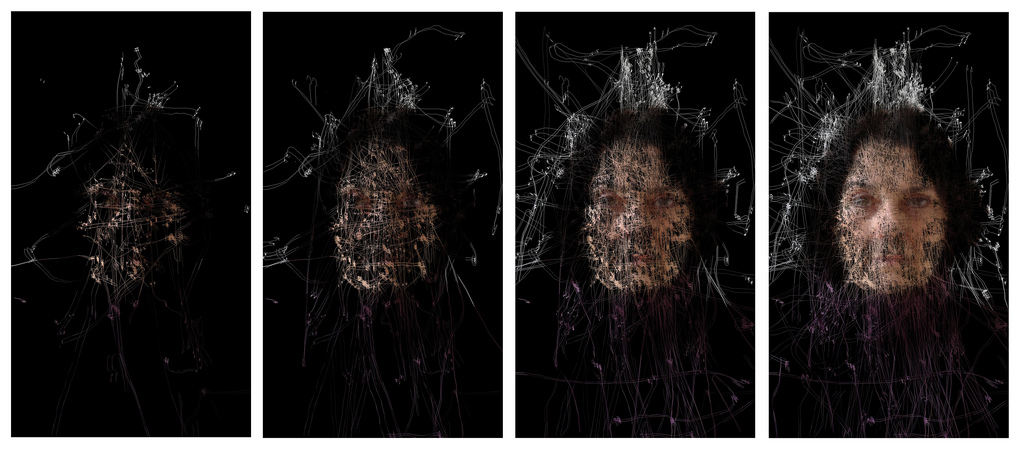
The Memory we always wanted or the Memory we never asked for? The TOTAL RECALL is the exhibition accompanying the theme symposium. It focuses on the cartography of the human brain, DNA as nature’s memory, and the history of mnemonic apparatuses and media, but it also deals with the dilemma of Information Society pinned between a rock and a hard place: the manic effort to archive everything and fear of digital memory’s omnipotence. Selected examples also show how media artists and internet activists as well as the so-called Big Bad Companies are coming to terms with this situation.
Digital Memory

Google has already been giving thought to how users can prepare their digital ego for the time after their death. What they’ve come up with is a service: Google Inactive Account Manager.
Anyone who isn’t content to leave digitization of books—that is, humankind’s literary heritage—up to Google Books can digitize his/her own. It’s easy when you do it with DIYBookScanner, which Daniel Reetz (US) built with a low-priced compact camera and freeware.
Commissioned by Intel, the Museum of Me depicts one’s personal Facebook network as an online portrait gallery, graphically represents a user’s social life on the internet including his/her digital footprint, and thus erects a monumental commemorative site to an individual netizen.

To protect his processor and thus a portion of his memory from hackers, snoops and censors, Hiroto Ikeuchi (JP) constructed Fantasy captured in plastic model, a desktop diorama in which toy soldiers stand guard.
Self-depiction, World representation

Careless dealings with one’s personal data and, in many cases, an almost obsessive urge to expose one’s private affairs in public social networks motivated artist Doris Graf (DE) to take action. For her Pikträts, she interviews internet users—including visitors to the Ars Electronica Festival. She impudently pries into precisely those data that social websites prefer to gather with soberly worded online forms, and then depicts the qualities and characteristics of her interlocutors in the form of pictograms. Framed and arranged in rows and columns, the Pikträts clearly reveal the extent to which human individuality on the internet—despite all promises of personality development—is reduced to a few facts for the purpose of economic utility.
The Table of Gazes by Mariano Sardón and Mariano Sigman (AR) deals with another form of portraiture. This project uses eye-tracking to document how people look at each other and recognize one another. The Table of Gazes thus renders a new type of portrait art that unites subjective and objective points of view.
An individual’s essential traits are also of primary interest to Werner Pfeffer (AT) in his project entitled House of Creativity, an online collection of mental strategies. Exhibition visitors are invited to relate their personal assessments of what life is all about.
The World Map Archive is the world’s only collection of first attempts to draw a map of the world. Benjamin Pollach (DE) has been collecting such efforts for many years now—for instance, in Peru, Bangladesh, Mexico and California. Now, visitors to the Ars Electronica Festival are invited to contribute their view of our planet.
An Arboreal Wonder and an Android
The Japanese city of Rikuzentakata has gone to great lengths to commemorate the Miracle Pine Tree, the only one of 70,000 such pines to survive the tsunami caused by the 2011 earthquake. The tree, which died shortly afterwards, has since been restored in its original shape and size. The replica now stands in the place of its predecessor.

A sort of Japanese national treasure in his own right is Beicho Katsura III, the supreme master of Rakugo, the ancient Japanese art of recitation. The resemblance of the Beicho Android by robotics genius Hiroshi Ishiguro (JP) to the human on which it was modeled is nothing less than astounding, and is simultaneously a promising strategy for the preservation of this art form.
Camera Work
Oliver Bimber (AT) is likewise involved in a new method to produce likenesses: light-field photography. Using a light-field & lytro camera he developed himself, he captures the light distribution throughout an entire space to produce a data model that allows for a completely new form of registering and reconstructing images. A sharp contrast to this is provided by remarkable historical artifacts from the collection of the Technical Museum in Vienna (AT). They show how people in the 19th century depicted the world three-dimensionally.
Scientist Reinhard Nestelbacher (AT) has come up with a truly futuristic idea for producing pictures. For The Cell Camera, he modifies human cells and cultivates them as a one-cell-thick layer. Chemicals used in cancer therapy sensitize these cells to light. Beneath a black-and-white negative illuminated by a laboratory lamp, the cells form a picture that corresponds to the negative.
Into Eternity by Michael Madsen (DK) is a documentary film about Onkalo, Finland, the world’s first storage depot for radioactive waste. It’s also about what sort of operating instructions we should leave our descendants—for instance, in 100,000 years.
Its cinematic counterpart is a documentary entitled Diverseeds by Markus Schmidt (AT) about maintaining the variety of seeds and plants in Asia and Europe.
The Good Old LP
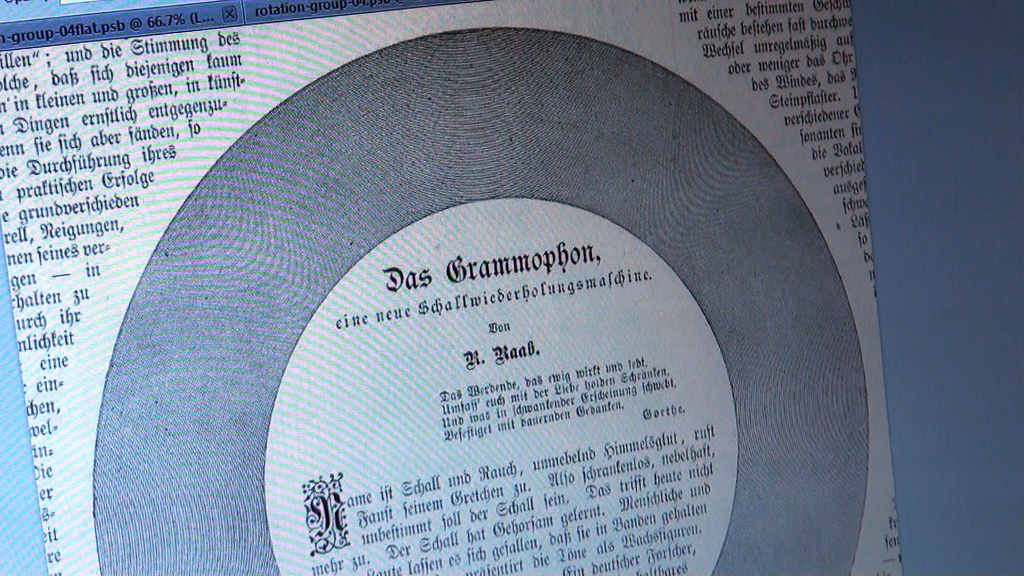
An extraordinary find is the Oldest Record of History, which had only been preserved in a photograph. Solely on the basis of this image, Patrick Feaster (US) succeeded in reconstructing, as it were, this phonograph record and the spoken word recordings it contained!
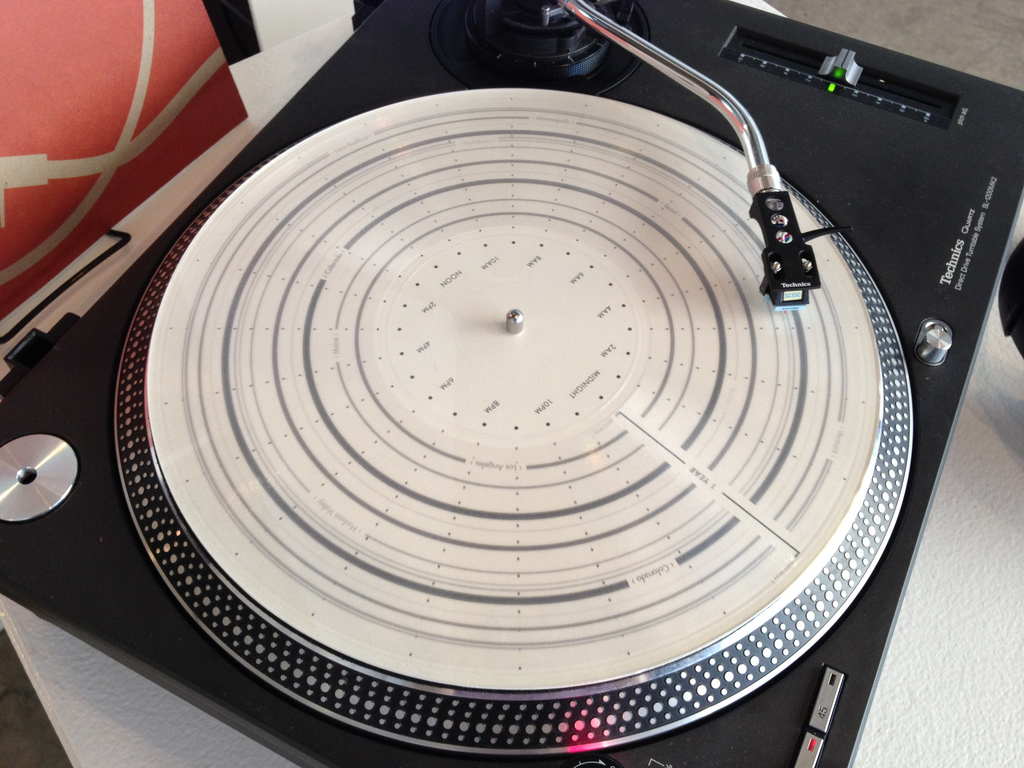
No less remarkable is the Quotidian Record, an acoustic autobiography pressed in vinyl by Brian House (US). It contains an acoustic form of the tracking data from every location House spent time in over the course of a year. That time period passes in fast-forward: 1 revolution = 1 day, so the 365 days of the year take 11 minutes to play back.

The recipient of a Prix Honorary Mention, The Sound of the Earth by Yuri Suzuki (JP) likewise works in fast-forward mode: around the world in 30 minutes. Each country on this playable world map is represented by its own sounds ranging from folk music to hymns to pop songs to segments of radio broadcasts.
Homage to the Tape Recorder

The Toki Ori Ori Nasu – Falling Records installation by Ei Wada (JP) is an homage to the analog tape recorder and a pleasure to behold—old-fashioned audio technology placed on classic pedestals, from which the played-out tapes cascade down into a glass display case where they twist and fold into fascinating layers, pattern and interwoven forms.
Michelle Ngai and Keith Lam of Dimension+ (HK/TW) work with another medium that has long since disappeared from everyday use: the cassette. Device Playing – Cassette Recorder (II) scans the magnetic field between the magnetic heads of a cassette recorder and the reel of magnetic tape, translates it into sound (which changes along with the varying strength of the magnetic field) and transfers it to an iPod.

Yusuke Tominaka, Shigeki Shimizu, Yusuke Nakamura, Atsushi Msamori and Hiroya Tanaka of Hiroya Tanaka Laboratory (JP) also enable sound to assume spatial dimensions. Wave Form Media is an original process to turn the sound waves—of recorded music, for instance—into individualized objects that can be worn like pieces of jewelry, and make it possible to reconstruct the original tonal material.
The Total Brain
The aim of the Big Brain Project by Joaquin Fargas (AR) is the creation of a world brain. To achieve this, neuron cells are to be cultivated and activated in as many labs as possible—starting with the Ars Electronica Center and the Maimonides University in Buenos Aires(AR)). These cells will be interlinked online, with the internet assuming the role of synapses.


Poking Florian, Fraunhofer-Institut für bildgestützte Medizin (DE)
Transmit energy through your fingers to activate sections of Florian’s white matter. Explore the physical 3D model of a brain from an actual adult, visualizing the paths of fibers which flow through the brain and are responsible for Florian’s bodily functions.Disclaimer regarding the printed program: A picture of this project has been used without giving the credit. The copyright lies with Peckerson GmbH / Fraunhofer MEVIS featured by MPI
Real brain specimens preserved by Vienna’s Natural History Museum (AT) can be viewed in the Brain Gallery, where they’re juxtaposed to digital models generated by state-of-the-art methods used at the Max Planck Institute for Human Cognitive and Brain Sciences in Leipzig (DE) and by Hans Ulrich Dodt (DE) at the Vienna University of Technology (AT).
Beautiful Minds: The Psychology of the Savant is the title of a made-for-TV documentary by Petra Höfera (DE) and Freddie Röckenhaus (DE) about people with Savant Syndrome, a condition in which a person with serious mental disabilities, including autistic disorder, demonstrates profound and prodigious capacities or abilities far in excess of what would be considered normal.
The Memory of Nature
Human DNA traces found in public places are the raw material Heather Dewey-Hagborg (US) used to create the portrait sculptures in her Stranger Visions series. Her aim is to point out DNA’s memory function as well as to call attention to the danger of a culture of genetic surveillance.
Suspect Inversion Center by Prix Ars Electronica prizewinner Paul Vanouse (US) is an open lab in which the artist uses his own DNA to produce copies of the historic DNA images from O. J. Simpson’s 1995 murder trial.
The bodymetries installation by Theresa Schubert (DE), Moritz Dreßler (DE) and Michael Markert (DE) invites those who behold it to interact with a computer simulation that assigns configurations of human moles to the protoplasmic tissue of an acellular slime mold (Physarum polycephalum) and thus applies an alternative method of decentralized cell organization to the human body.
Never Forget –Culture of Commemoration, Politics of Memory
Yad Vashem in Jerusalem (IL) is the most important memorial site and research facility dedicated to the Nazi’s genocide of the Jews. Its prizewinning online presence is a reference project for the use of the internet as a medium of commemoration and
remembrance.
In the TOTAL RECALL Exhibition, the Yad Vashem website with its online archive of names and images of many of the millions of victims of the Holocaust is also the point of departure for confrontations with the memorial sites at Hartheim and Mauthausen. Festivalgoers will have the opportunity to visit these two places located near Linz.
Schloss Hartheim in Alkoven is a Renaissance palace that served from 1940 to 1944 as a Nazi euthanasia facility. Here, approximately 30,000 human beings—physically and mentally handicapped persons, the mentally ill, concentration camp prisoners (most from Mauthausen and its subsidiaries) and slave laborers—were systematically murdered. Today, Hartheim is an educational and memorial site. The Mauthausen concentration camp 20 kilometers east of Linz was the largest German concentration camp in Austria during the time of National Socialism.
A Class of Its Own

When it comes to visually mediating encounters with art and art history, Ikono.TV (DE) is in a class by itself. Its unique aesthetic and technical quality and the absence of know-it-all voice-over accompaniment make Germany’s first art-only channel the ideal setting in which to consider works of art, festivals and individual artists—for instance, Alexander Schellow (DE) and his work Drawing. His animated renderings take shape in a rigorously structured procedure as point-by-point drawings, which is what enables the artist to access his visual memory.
Brucknerhaus
Do 5. 9. 10:00 – 19:00
Fr 6. – Sa 7. 9. 10:00 – 17:30
So 8. – Mo 9. 9. 10:00 – 19:00
CyberArts - Prix Ars Electronica 2013
The CyberArts – Exhibition shows the award-winning works of the Prix Ars Electronica 2013.
El Campo de Cebada
El Campo de Cebada (ES)
Golden Nica Digital Communities
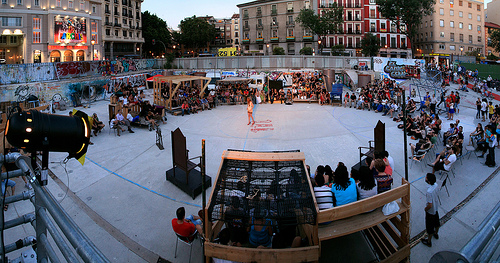

El Campo de Cebada (the barley field) is both a physical and a virtual space, an open source domain in downtown Madrid. Originally a swimming pool complex, it became a 3,500-m2 vacant lot in the heart of town, since, due to the financial crisis, there were no funds to erect a new facility. Following negotiations with municipal officials, El Campo de Cebada was successfully self-administered by locals. The prime determinant was a completely transparent open data policy both online and on-site. All meetings are open to everyone; the resource management process is open and can be viewed by anyone at any time.
Refugees United
Christopher Mikkelsen (DK), David Mikkelsen (DK)
Award of Distinction Digital Communities
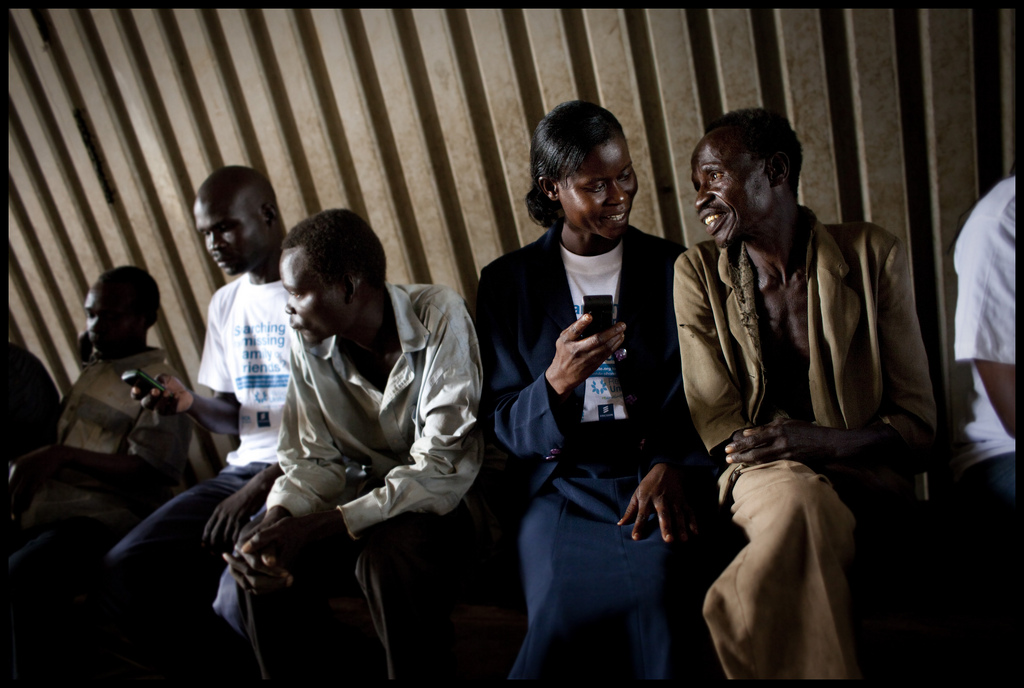
Refugees United is a non-profit organization that makes a global, anonymous, user-driven search system available to families of refugees, which enables them to search for missing relatives independently of third parties.
Visualizing Palestine
Visualizing Palestine (PS)
Award of Distinction Digital Communities

Visualizing Palestine is committed to social justice and change for the better in Palestine. It focuses on the failure of the organizations involved in the Israeli-Palestinian conflict, effective deployment of communication tools (and not relying exclusively on dry-as-dust reports, tables and graphics) and the inability of the media to deliver unbiased coverage (instead of providing one-sided reportage that concentrates on Hamas). The response that this crew’s data analysts and media designers have come up with features data put forth in an attractive, coherent way.
The Cosmopolitan Chicken Project
Koen Vanmechelen (BE)
Golden Nica Hybrid Art
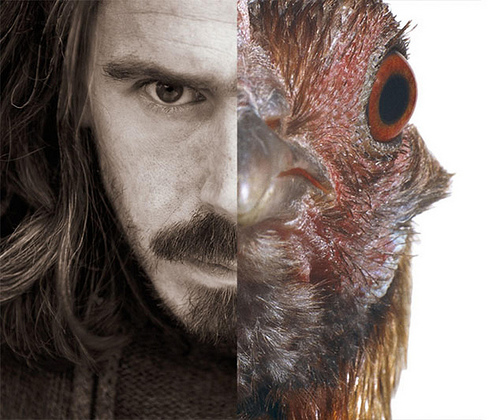



The investigation of biocultural diversity and identity that Vanmechelen has been conducting since 1999 combines art, science and aesthetics. In his Cosmopolitan Chicken Project, the artist has crossed species of chickens from many different countries. The aim: breeding cosmopolitan poultry with genetic material from every one of the world’s chicken species.
Five Variations Of Phonic Circumstances And A Pause
Tania Candiani (MX)
Award of Distinction Hybrid Art


This work by Tania Candiani tunes in to the culture of hearing and audio technologies. It’s based on speaking machines and hearing systems, which she implements for poetic actions with machines, language, codification and the audio texture of narration. Each of the machines in Five Variations … addresses and expands on a particular conception associated with devices, instruments or technologies, and subjects their sounds or tonal characteristics to a variation.
Mycotecture
Phil Ross (US)
Award of Distinction Hybrid Art

Since the early 1990s, Phil Ross has been experimenting with living fungi which he introduces into a medium such as sawdust. Within a week, the mixture solidifies into a very versatile, plaster-like mass that Ross has used to construct furniture and a teahouse. The fact that it’s 100% organic and biodegradable isn’t the only reason why his invention is a terrific sustainable alternative to petroleum-based materials.
The Blind Robot
Louis-Philippe Demers (CA/SG)
Honorary Mention Hybrid Art


Louis-Philippe Demers set out to transform a robot arm from a cold precision tool into a sensitive instrument, and thereby create a new form of intimate touch by social robots. In his installation, the mechatronic arm gently feels the faces and upper bodies of installation visitors just like a blind person would do. Finally, a monitor depicts what the robot “saw” in going about this.
Pancreas
Thomas Feuerstein (AT)
Honorary Mentions Hybrid Art
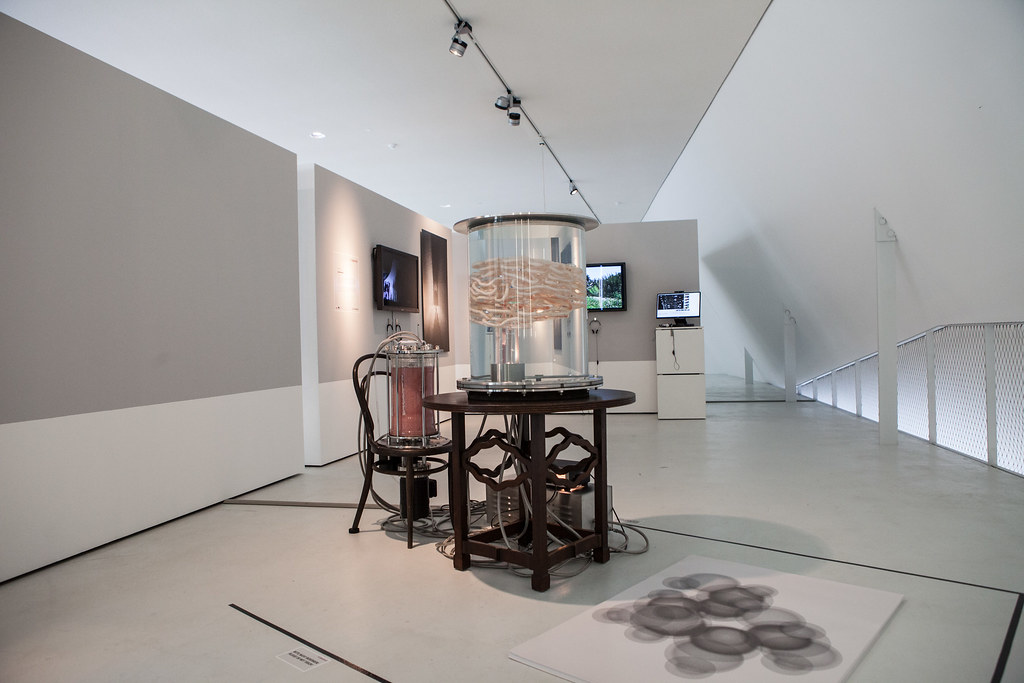
Pancreas is a processual sculpture that converts books into sugar that, in turn, serves as nourishment for human brain cells. Book pages that have been shredded and soaked in water are put into a bio-fermenter serving as an artificial intestine where bacteria break down the cellulose into glucose. Once this material is filtered and cleaned, it’s fed to brain cells in a glass container. But this artificial brain is on a strict diet—its sole source of nutrition is one of the milestones of philosophy, Hegel’s The Phenomenology of Spirit.
frequencies (a)
Nicolas Bernier (CA)
Golden Nica Digital Musics & Sound Art
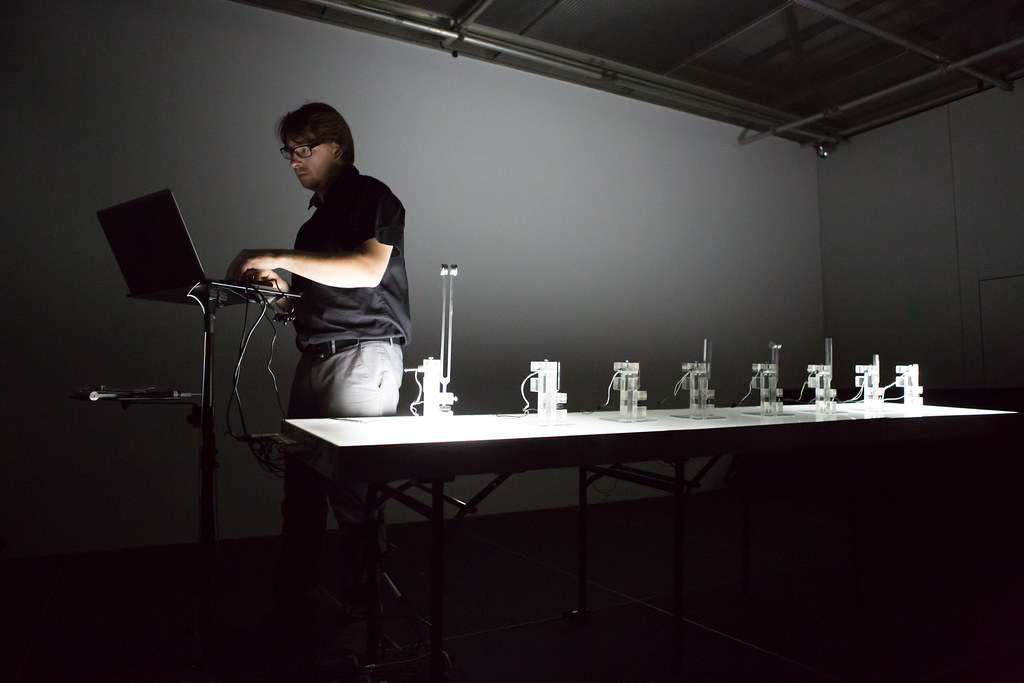

frequencies (a) is a sound performance combined with light. It blends digital sounds with the crystal-clear tones of a tuning fork. By means of computer-controlled magnetic vents, Bernier imparts precise strikes to a tuning fork. This is accompanied by the pulsating of glistening lights, and the space is filled by a composition of light and sound.
Borderlands Granular
Chris Carlson (US)
Award of Distinction Digital Musics & Sound Art
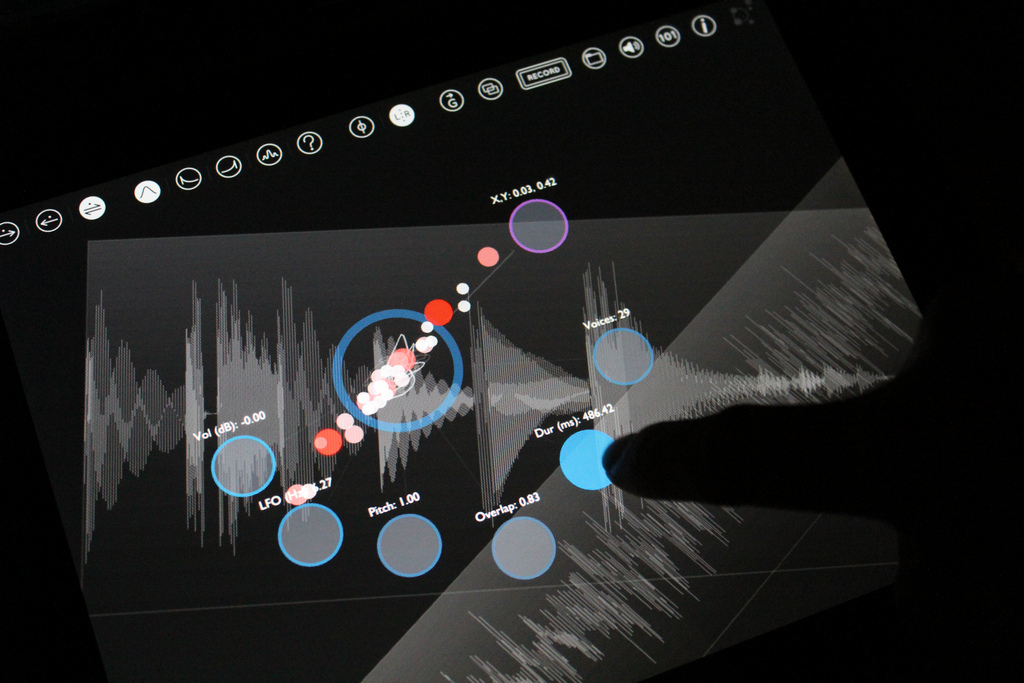
Borderlands Granular is a new musical instrument that makes it possible to experiment with, touch and modify sounds by means of granular synthesis, a technique that uses stratification and/or overlapping of very brief sound fragments or “grains” to produce complex, dynamically changing timbres and tonal structures. The software supports flexible improvisation in real time and enables users—defined as organizers of sounds—to work directly with sound material even if they lack any formal musical background.
SjQ++
SjQ++ (JP)
Award of Distinction Digital Musics & Sound Art
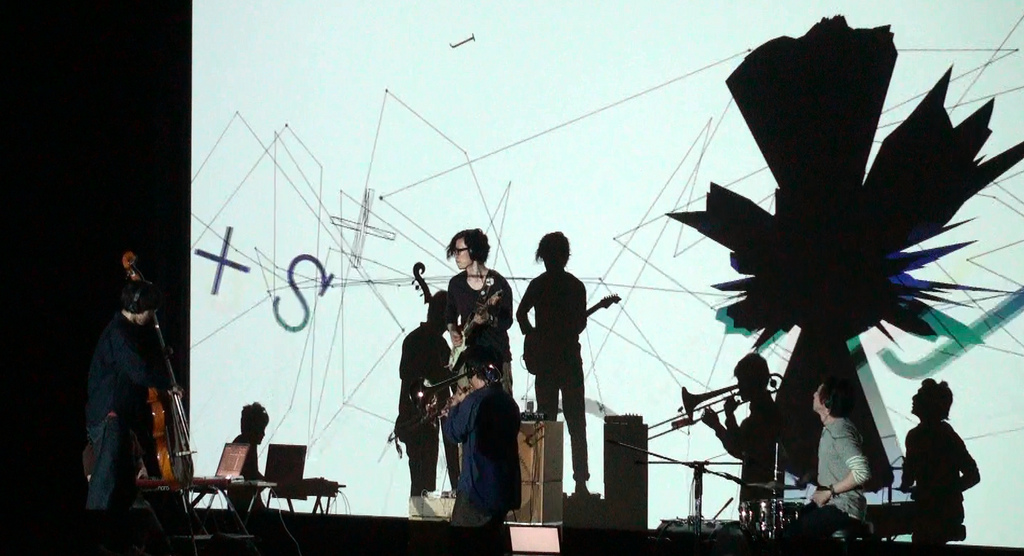
This audiovisual tool enables multiple users to simultaneously compose music in real time. Via interaction, participants create sound data that are, in turn, visualized and depict the behavior of the respective users. The audience experiences the performance as an inseparably interwoven construction of sounds and visual elements. The sounds and images are not only perfectly synchronized; they also reciprocally influence and modify one another.
Pendulum Choir
Michel Décosterd (CH), André Décosterd (CH)
Golden Nica Interactive Art
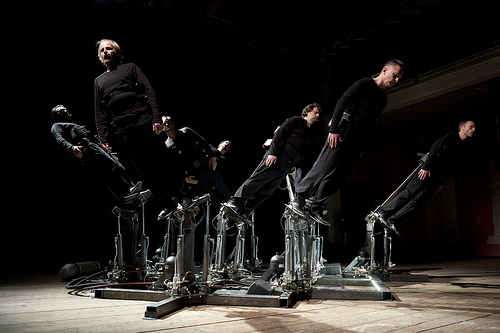
Pendulum Choir is choral piece for nine a cappella voices and 18 hydraulic cylinders. The singers are engaged in a battle/playful encounter with gravity on tilting pedestals that, as an ensemble, form a living tonal body. This assumes various physical states that, in turn, influence its acoustic behavior—abstract, repetitive, lyrical or narrative. The forms of expression include subtle vocal polyphonies, lyrical flights of fancy, and dark, obsessive rituals.
Voices of Aliveness
Masaki Fujihata (JP)
Award of Distinction Interactive Art
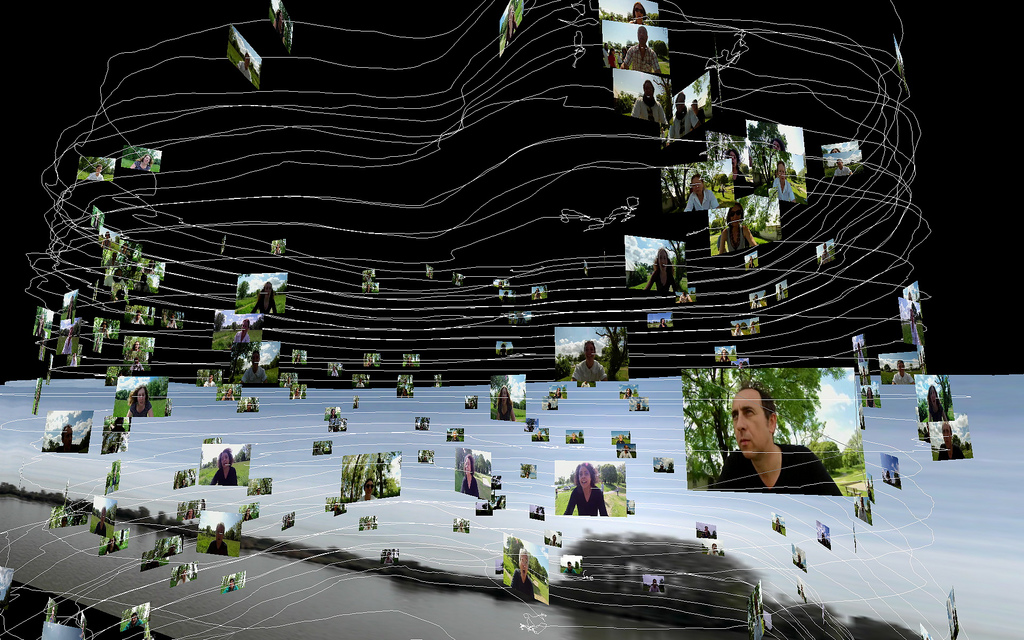
Participants ride a bicycle equipped with a GPS logger and a video camera around a track prepared especially for this project—the so-called shouting circuit. While doing so, they’re requested to scream their brains out! As a collection of these loops and cries, Voices of Aliveness is a collective vocal sculpture that will be reproduced in cyberspace in the form of a ring.
Rain Room
rAndom International (GB)
Award of Distinction Interactive Art
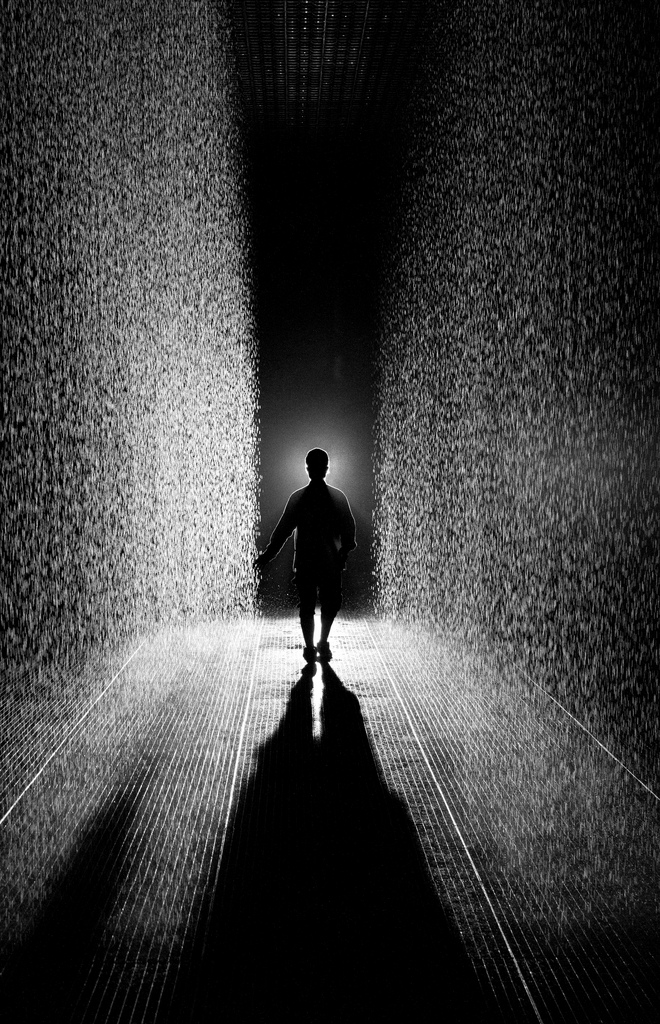
Rain Room is a 100-m2 field of dripping water. The meticulously choreographed rainfall reacts so sensitively to installation visitors’ presence and movements that they can cross this high-precipitation zone without getting wet.
Down with Wrestlers with Systems and Mental Nonadapters!
Kawarga Dmitry & Elena (RU)
Honorary Mentions Interactive Art


Via a treadmill, installation visitors set a “social mechanism” into motion and can feel a bit like God as they go about it, since the movement of the mechanism as well as of the figures inside depend on the visitor’s own pace. The upshot is experiencing a sort of split consciousness: Does society co-opt us all, or do we create this enslavement mechanism ourselves? Reciting the Dada Manifesto into a microphone causes the installation to vibrate and several of the figures begin to tumble out of it. A monitor displays images captured by a mini video camera inside a black box in which another reality is to be found: the world of the artist.
Ishin-Den-Shin
Olivier Bau (FR), Yuri Suzuki(JP), Ivan Poupyrev (RU)
Honorary Mentions Interactive Art
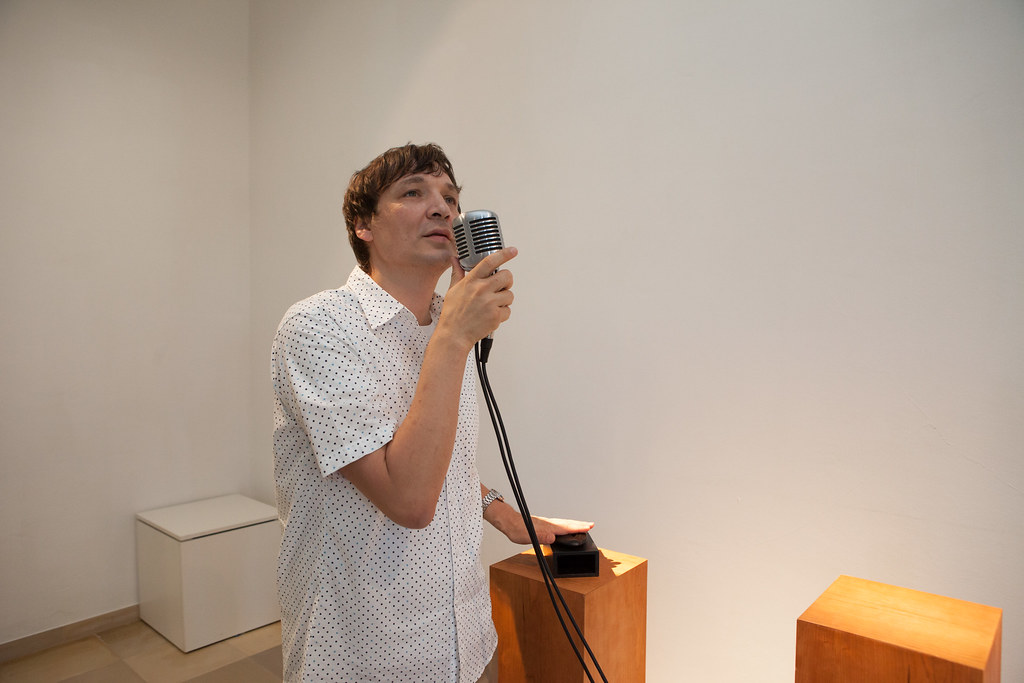


Ishin-Den-Shin turns the body into a transmission medium for intimate acoustic communication. The work consists of a microphone that can pick up sound and inaudibly, haptically project it onto the body of the person holding the microphone. The acoustic signal becomes audible only when touching that person’s ear—as if the finger whispered the recorded sounds into the ear that was touched.
Angles Mirror
Daniel Rozin (US)
Honorary Mentions Interactive Art


In his 2012-13 series Angles, Daniel Rozin applies a new form of geometric image production. It dispenses with the usual rectangular grid and is based instead on rotation. The Angles Mirror, a triangular block of steel with rotatable pointers—doesn’t construct the image out of various levels of lightness and darkness; instead, it depicts the mirror image of the viewer taken by the camera in the form of various angles of inclination. Rather than a photorealistic picture, the Angles Mirror represents the three-dimensional movement of a figure that results from the change of distance from the reflecting sculpture.
AHORA. A song in the Hypertemporal Surface
Hernán Kerlleñevich (AR), Mene Savasta Alsina (AR)
Honorary Mentions Interactive Art
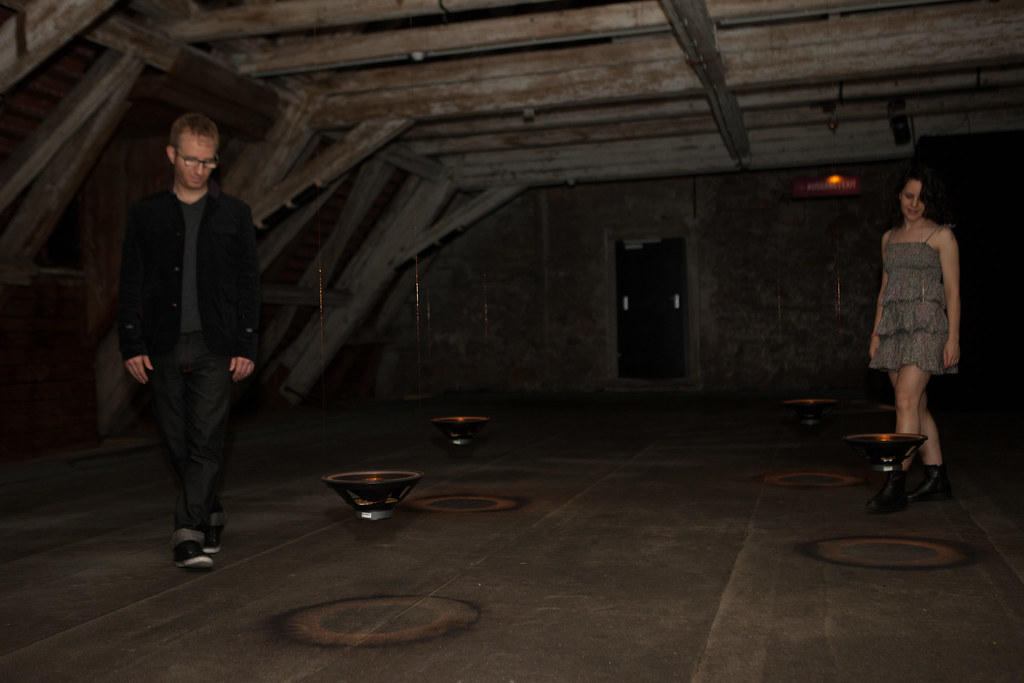
Software and installation, AHORA is a composition environment for music in space. A composed interactive song fragmented into its sound elements lies on the floor of the installation space. The sound elements make up the temporal corpus of the piece, which awaits the step of an installation visitor to make it resound. The sound elements are reordered depending on the visitor’s path, and thus the piece is rewritten depending on the particular route.
The exhibition is shown at the OK Offenes Kulturhaus im OÖ Kulturquartier during the following hours.
OK Offenes Kulturhaus im OÖ Kulturquartier
Opening Thu 5.9. 18:00
Thu 5. – Fr 6.9. 10:00 – 21:00
Sat 7.9. 10:00 – 23:00
Sun 8. – Mo 9.9. 10:00 – 21:00
LENTOS Kunstmuseum Linz
Vernissage: Wed 5.9. 19:00
Exhibitiontour with HR Giger including book-signing: Thu 5.9. 14:30
Thu 5. 9. 10:00 – 21:00
Fri 6. – Mon 9. 9. 10:00 – 19:00
HR Giger – The Art of Biomechanics
Ars Electronica’s featured artist is HR Giger. The painter, graphic artist and designer was born in 1940 in Switzerland. He’s an art world outsider and the legendary creator of biomechanics and the Oscar-winning creature in “Alien.” This embodiment of fear and horror, the intruder from beyond in Ridley Scott’s classic sci-fi film, has been a pop culture icon since 1980 and made Giger’s inimitable style world famous.
Giger is part of the 1960s avant-garde but his roots extend back into the art history of the 19th century. He is indeed a painter, but has made the airbrush his primary tool.
Fears and Obsessions
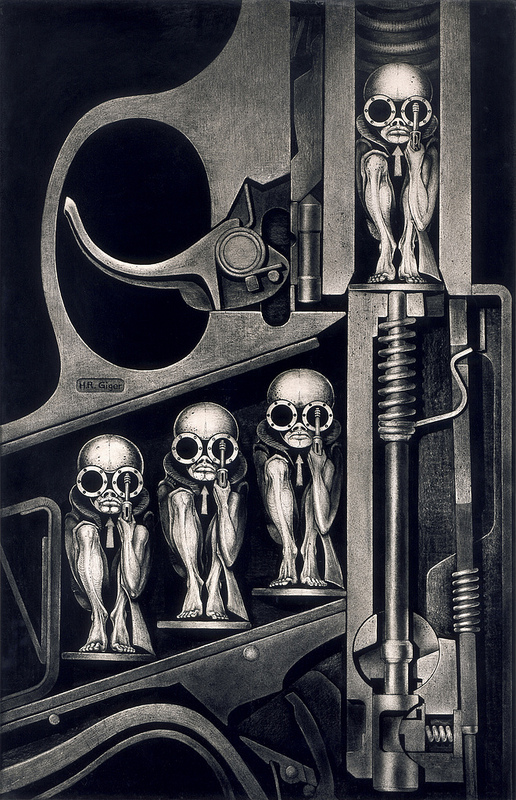
Gebärmaschine (1968)
As one of the leading innovators in the fantastic art genre, Giger’s art draws upon his childhood fears and obsessions, above all humankind’s collective fears of global atomic warfare and of being victimized by technological progress. Obsessed by the cycle of birth, eros and death, the artist merges technology, mechanics and organic creatures into frightening “bio-mechanoids” and thus visions that anticipated cyborgs.
From Necronom to Prometheus
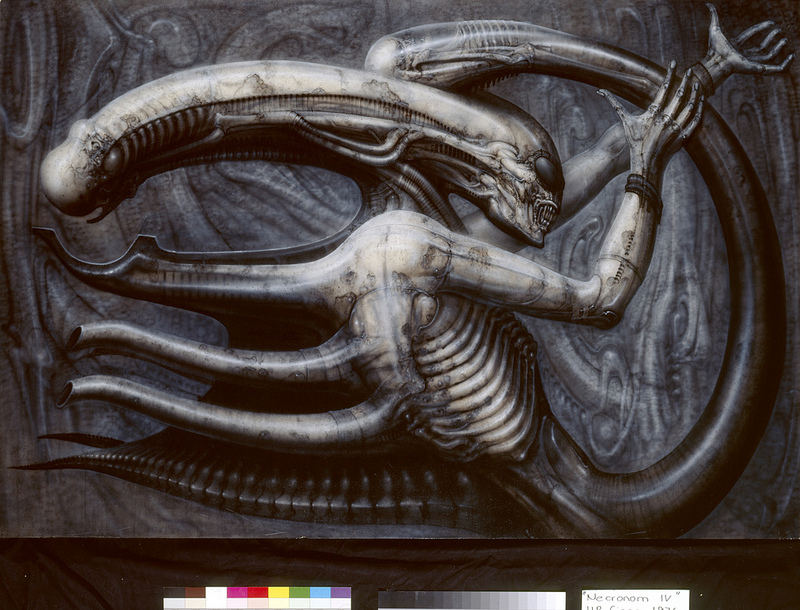
Necronom IV (1976)
The exhibition in Linz’s Lentos Art Museum features paintings, drawings, films and sculptures that reveal the development of Giger’s biomechanical style. Accompanied by original props, design sketches and the Alien Diaries, the exhibition traces his career from the Necronom cycle from the 1970s to Alien and all the way to Prometheus, Giger’s latest design—once again for a film by Ridley Scott.
In Deep Space at the Ars Electronica Center, stunning gigapixel images will plunge viewers into the depths of HR Giger’s cosmos.
A project by HR Giger, LENTOS Kunstmuseum Linz, Museum HR Giger Gruyères and Giger-collector Marco Witzig. Curated by: Andreas Hirsch (AT)
LENTOS Kunstmuseum Linz
Vernissage: Wed 5.9. 19:00
Exhibitiontour with HR Giger including book-signing: Thu 5.9. 14:30, Tour with HR Giger (CH), Gerfried Stocker (AT), Stella Rollig (LENTOS Kunstmuseum / AT) und/and Andreas Hirsch (AT)
Thu 5. 9. 10:00 – 21:00
Fri 6. – Mon 9. 9. 10:00 – 19:00
IL(L) Machine – Ars Campus Israel
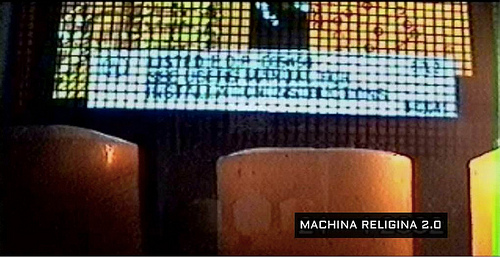
Kunstuniversität Linz
Opening: Thu 5.9. 16:00
Thu 5.9. 16:00 – 19:00
Fri 6. – Mon 9. 9. 10:00 – 19:00
This year’s Campus Exhibition offers a rare opportunity in Austria to encounter young media artists from Israel. The innovative tweak for 2013: the spotlight won’t be on a single art college. IL(L) Machine is being staged in cooperation with Israel’s 10 leading academic institutions including schools in Jerusalem, Tel Aviv, Haifa and Ramat Gan.
Israel’s Leading Schools
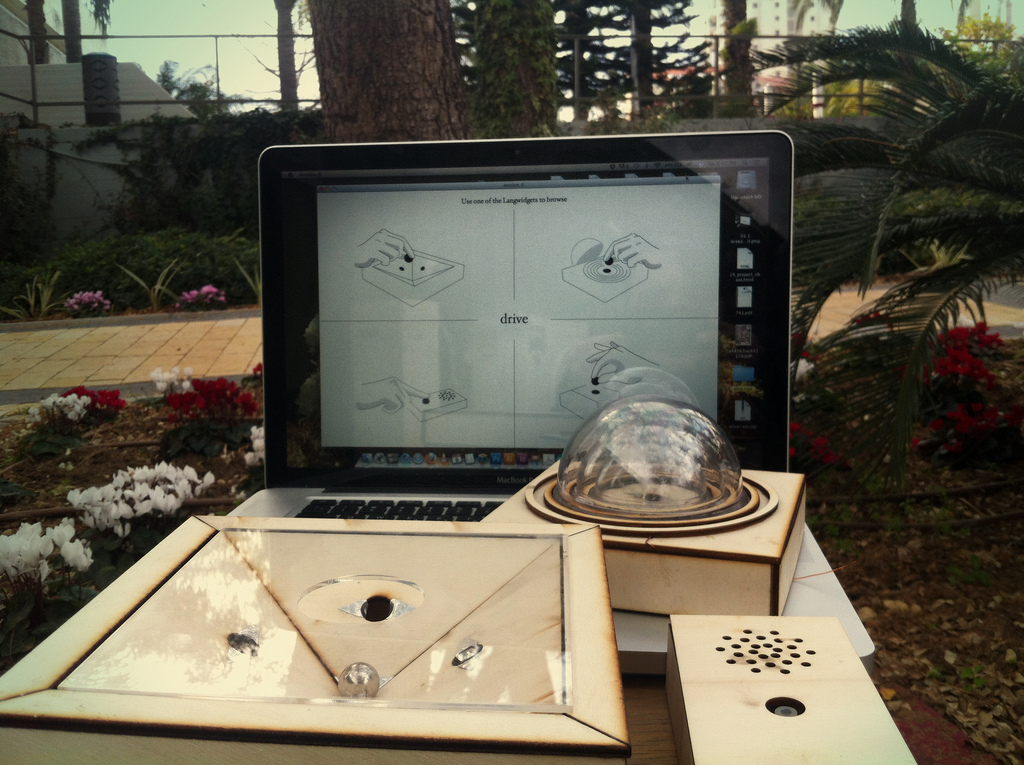
Participants are Bezalel Academy of Arts and Design, Hamidrasha Art School of Beit Ber College, Holon Institute of Technology, Kibbutzim College of Education, Technology and the Arts, Shenkar College of Engineering and Design, the Media Innovation Lab at IDC Herzliya, Musrara School, the Neri Bloomfield School of Design and Education, Hadassah Academic College and Technion – The Israel Institute of Technology.
A Difficult Setting
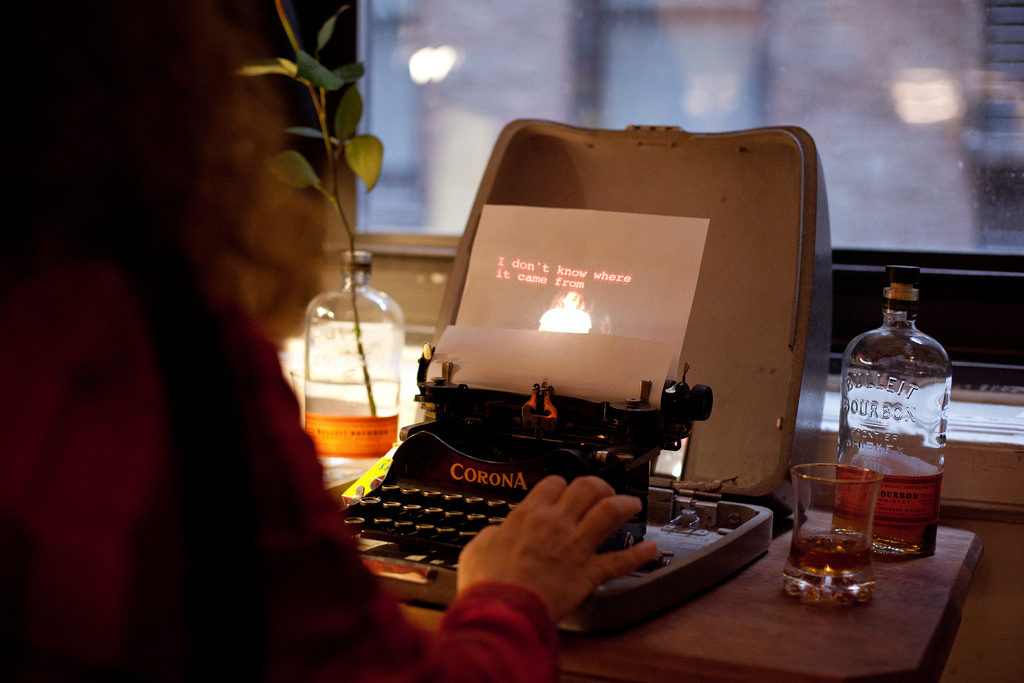
These art academies and research facilities are the proving grounds from which a new generation of artists is emerging. Despite existential problems, they are extremely productive. In their works, they often deal critically with how technology has come to pervade everyday life.
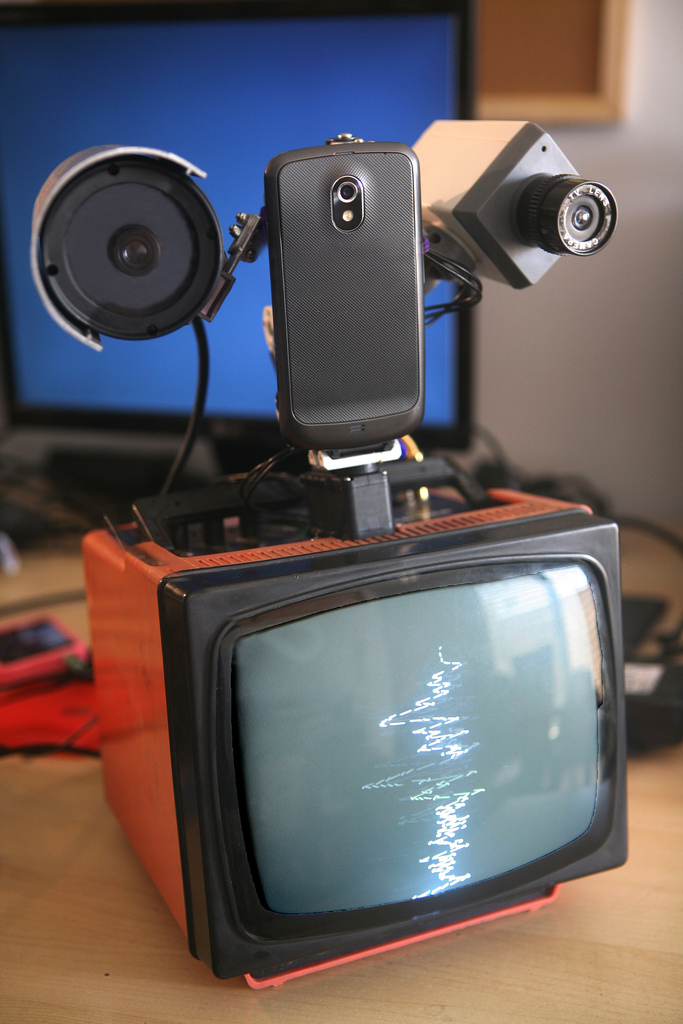
In a multicultural country with an identity that is burdened by historical baggage, a country characterized both by serious political conflicts and by world-class high-tech industries, this critical confrontation with the influence of new technologies on Israeli society has brought out an array of fascinating perspectives.
Local-Global Balancing Act
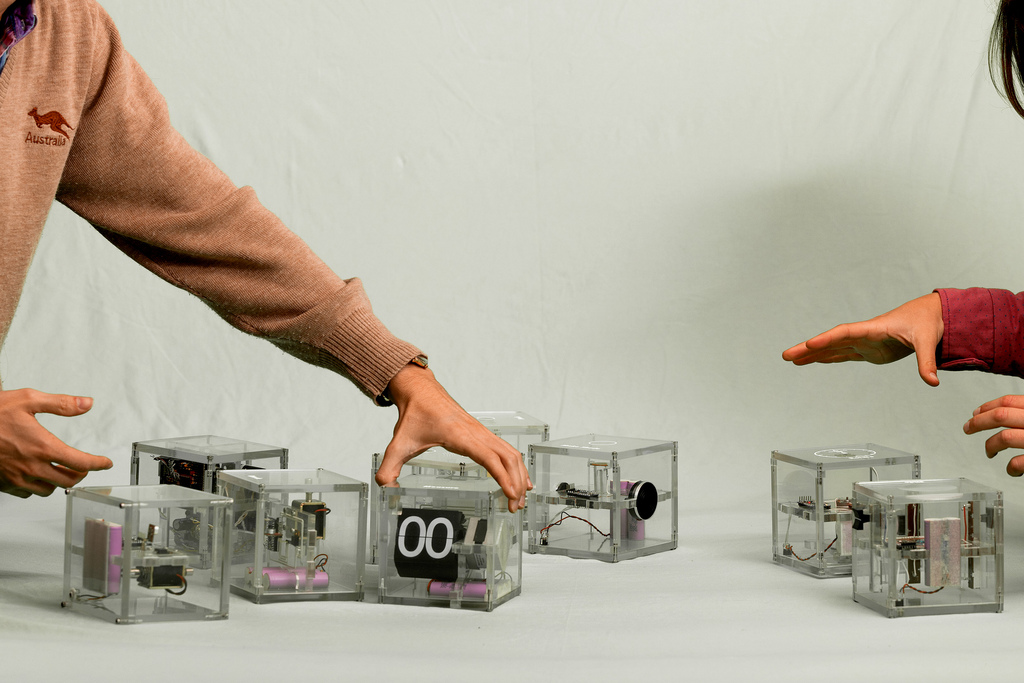
IL(L) Machine is a great opportunity to get acquainted with these points of view, but this exhibition also mirrors Israeli art’s current conflict, an outgrowth of the contradiction between having to deal with the complex issues that characterize the realities of life in Israel and artists’ endeavors to make a name for themselves in the international art scene.
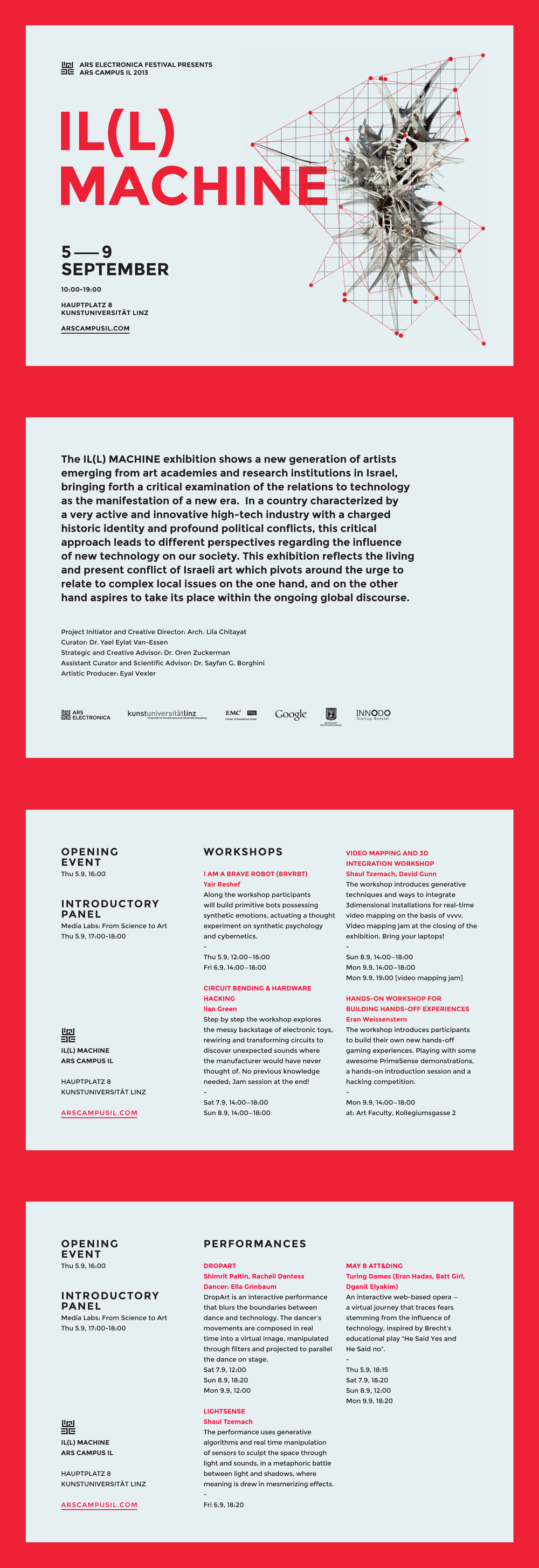
With works by Yonathan Abramson & Michael Fink & Dani Bacon, Noam Attias, Eitan Bartal, Batt-Girl, Moti Brecher, Lila Chitayat & Alon Chitayat & Shalom Amira, Racheli Dantess & Shimrit Paltin, Amnon Dekel, Ori Drumer, Ron Erlih, Liliana Farber, Adi Fleisher Peled & Yael Cohen, Eran Hadas & Batt-Girl & Dganit Elyakim, Or Galor, Itamar Gilon & Noam Gefen & Omri Sass & Ran Snir & Sharon Heller, Alisa Goikhman, Ilan Green, Inbal Her-shtig, Guy Hoffman & Roberto Aimi, Gadi Ickowicz & Tal Kammer & Lihi Erel & Maya Friedman & Maya Shoham, Dina Kornveits, Yuri Klebanov & Roi Ronn & Yonatan Ben Yaakov, Daphna Levin, Ori Levin, Dor Zlekha Levy, Alex Man & David Malik & Doron Barsky & Yael Laventer & Tamar Garfunkel, Inbal Pinto & Matan Zohar, Michal Rinot, Roi Ronn, Harel Schreiber, Doron Segal & Jenny Bahar & Shahar Yaacoby & Itay Kurgan, Maayan Sheleff & Eran Hadas & Gal Eshel, Itamar Shimshoni, Yonathan Ben Simchon, Shaul Tzemach, The Technion, Or Wolff, Oren Zukerman (IL)
Project Team
Lila chitayat – project initiator and Creative Director
Yael Eylat Van-Essen – Curator
Oren Zukerman – Strategic and Creative Adviser
Sayfan Borghini – Scientific Advisor and Assistant Curator
Eyal Vexler – Artistic Producer
Kunstuniversität Linz
Opening: Thu 5.9. 16:00
Thu 5.9. 16:00 – 19:00
Fri 5. – Mon 9. 9. 10:00 – 19:00
Back to top
Project Genesis - Yours synthetically

Not too long ago, it cost millions to sequence a genome. Since then, the cost has dropped to a few thousand euros. It will soon be doable for peanuts.
For years now, we’ve been able to not only read genetic information but write it as well. Enabling humankind to configure all of life on Earth is the realm of possibilities of synthetic biology. The available options thus include resurrecting extinct species and endowing organisms with new characteristics, and doing so not only in big-time laboratories but in garages and home workshops too. Thus, in synthetic biology as well, there’s a do-it-yourself scene dedicated to the open source principle.
The possibility of designing living creatures on the drawing board raises incredibly complex ethical, social and ecological questions.
Project Genesis – Yours Synthetically is the first show to bring together artistic works as a means of stimulating a discussion of these issues. They get across how artists use technological achievements to investigate and understand nature, and often to assume a critical perspective in doing so.
With works by Art Orienté Objet (FR), Billy Apple (NZ) & Craig Hilton (NZ), Tuur Van Balen (BE), Sonja Bäumel (AT) & Manuel Selg (AT), David Benqué (UK), Heath Bunting, Oron Catts (AU) & Hideo Iwasaki (JP), Ben Fry, Shiho Fukurhara (JP) & Georg Tremmel (AT/JP), Matthew Gardiner (AU/AT), Alexandra Daisy Ginsberg (UK), Andy Gracie (UK/ES), Hackteria.org, Denisa Kera (CZ/SG), Le Laboratoire (FR), Jon McCormack (AU), Emiko Ogawa (JP/AT) & Hideaki Ogawa (JP/AT) & Naohiro Hayaishi (JP) & Takeshi Kanno (JP), Patricia Piccinini (AU), Tobias Revell (UK), RIXC (LV), Phil Ross, Theresa Schubert (DE) & Rüdiger Trojok (DE), Johanna Schmeer (DE), Science Gallery (IE), Maja Smrekar, Superflux Studio (UK), Georg Tremmel (AT/JP), Rüdiger Trojok, Paul Vanouse
Curated by Matthew Gardiner (AU/AT)
The exhibition is shown in the Ars Electronica Center, for more information click here ars.electronica.art/projektgenesis.
Interface Cultures - Use at your own risk!
Use at your own risk is an allusion to a commonly used disclaimer text, warning the potential user of a certain software or hardware circuit that its makers cannot made responsible for any possible use or misuse of their inventions. When developing prototypes, the authors usually have to evaluate the potential risk or threat that their device or installation poses to the visitors within a public exhibition, which may lead to limitations of its overall use that eventually constrain the full potential of all interaction possibilities. Nevertheless the risk factor is an entire part of the making and design of novel interfaces and devices that are in direct contact with the visitors, which cannot just be ignored. This warning title reminds the spectators that experimental artworks are no exception to that rule.
Brucknerhaus
Opening Thu 5.9. 13:00
Thu 5. 9. 10:00 – 19:00
Fri 6. – Sat 7. 9. 10:00 – 17:30
Sun 8. – Mon 9. 9. 10:00 – 19:00
WORKS
Random Readings
Cesar Escudero Andaluz (ES)
This media archeology project is based on the reinterpretation of an optical telecommunication device from 1787. It develops new interfaces (physical and graphic) by embedding current platforms such as webcams, telemonitoring systems, streaming channels or closed-circuit surveillance. The recognition system for video tracking detects the threshold color changes in five different points located on the image surface.
The information collected in these five points is decoded to an alphabetic system. Finally the letters are printed on the surface of the screen together with the previous values obtained. The final result is shown as an interactive installation that combines situations in public spaces with social control factors.
http://escuderoandaluz.com
Zuerst kommt das Fressen, dann kommt die Moral
Davide Bevilacqua (IT)

Vegetarians, optimized production, low-calories drinks, bio-fast-naturally colored dishes. We are surrounded by different foods, symbols of cultures and fashions. Food has always played a central role in social gatherings, as a cultural sign and a collective ritual. Each event has indeed its own type of refreshment: wedding breakfasts, buffets, brunches. This buffet provides the suitable refreshments for the Interface Cultures’ exhibition at the Ars Electronica Festival. The audience will enjoy a buffet made of experimental dishes and drinks. There will be original and collected recipes, some of them are close to the molecular kitchen, others to the DIY community. The selection follows a research lead by curiosity, lust for experimenting with food, discovering how ingredients react with each other and trying out new tastes and forms for usual dishes.
Sculpton
Alberto Boem (IT)
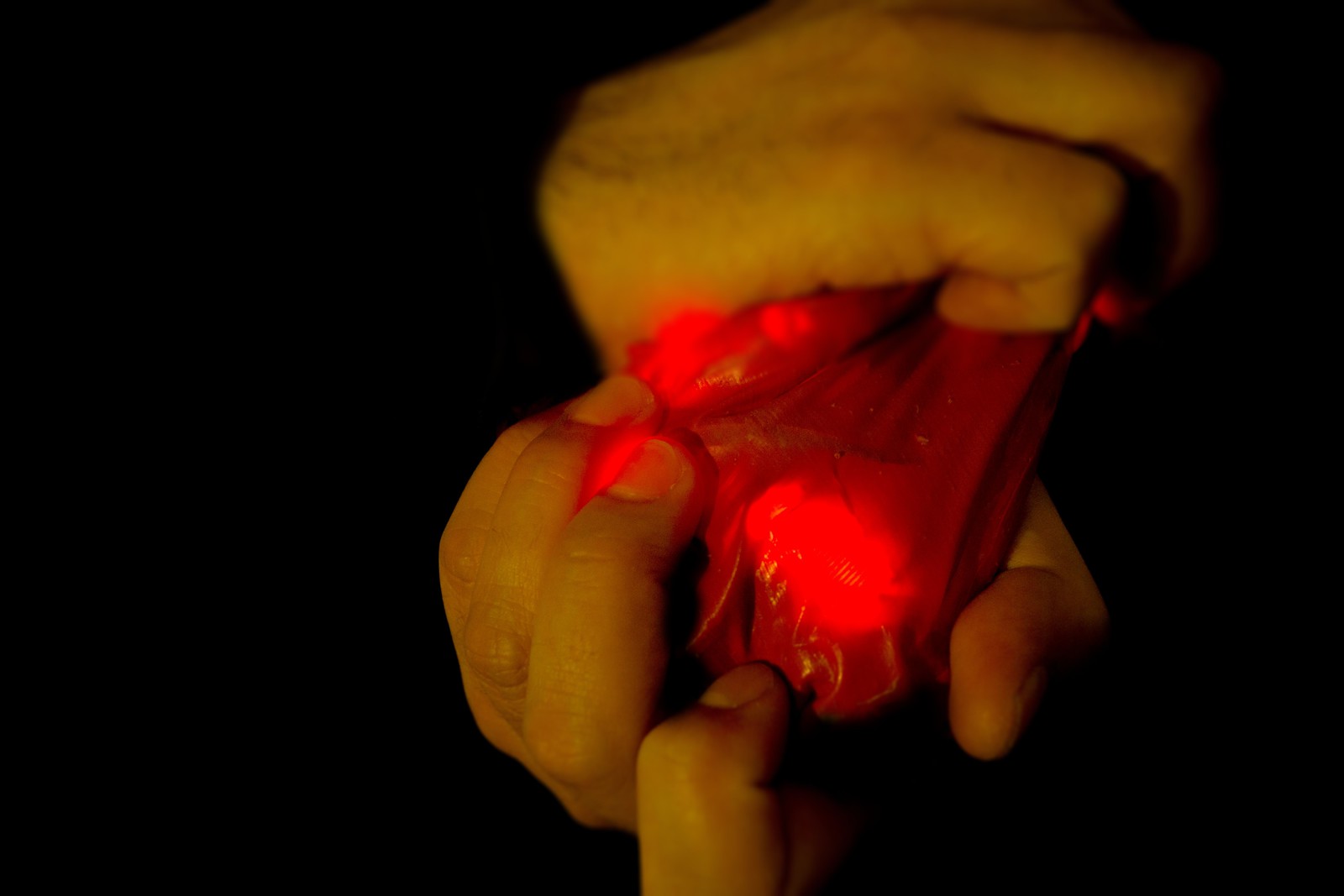
Sculpton is a malleable sonic object that uses the metaphor of sound sculpting for connecting physical information in digital audio. By manipulating the object the user can literally sculpt the sound through a real-time sound synthesis that reverberates the object structure. Sculpton is an attempt to develop a new kind of digital musical instruments that combines multidimensional control, tangible and malleable characteristics with organic handling. This quality has an intimate relation with the sound production: the user shapes the sound by molding the object. Beyond the idea of control, Sculpton represents a sonic object that promotes physical effort and engagement with musical and non-musical characteristics. Sculpton is an interface for musicians and performers strongly based on the idea of exploration and improvisation, a tool for composing electronic music on stage.
Arnulf Rainer for digital performers, concert version
Alessio Chierico (IT)
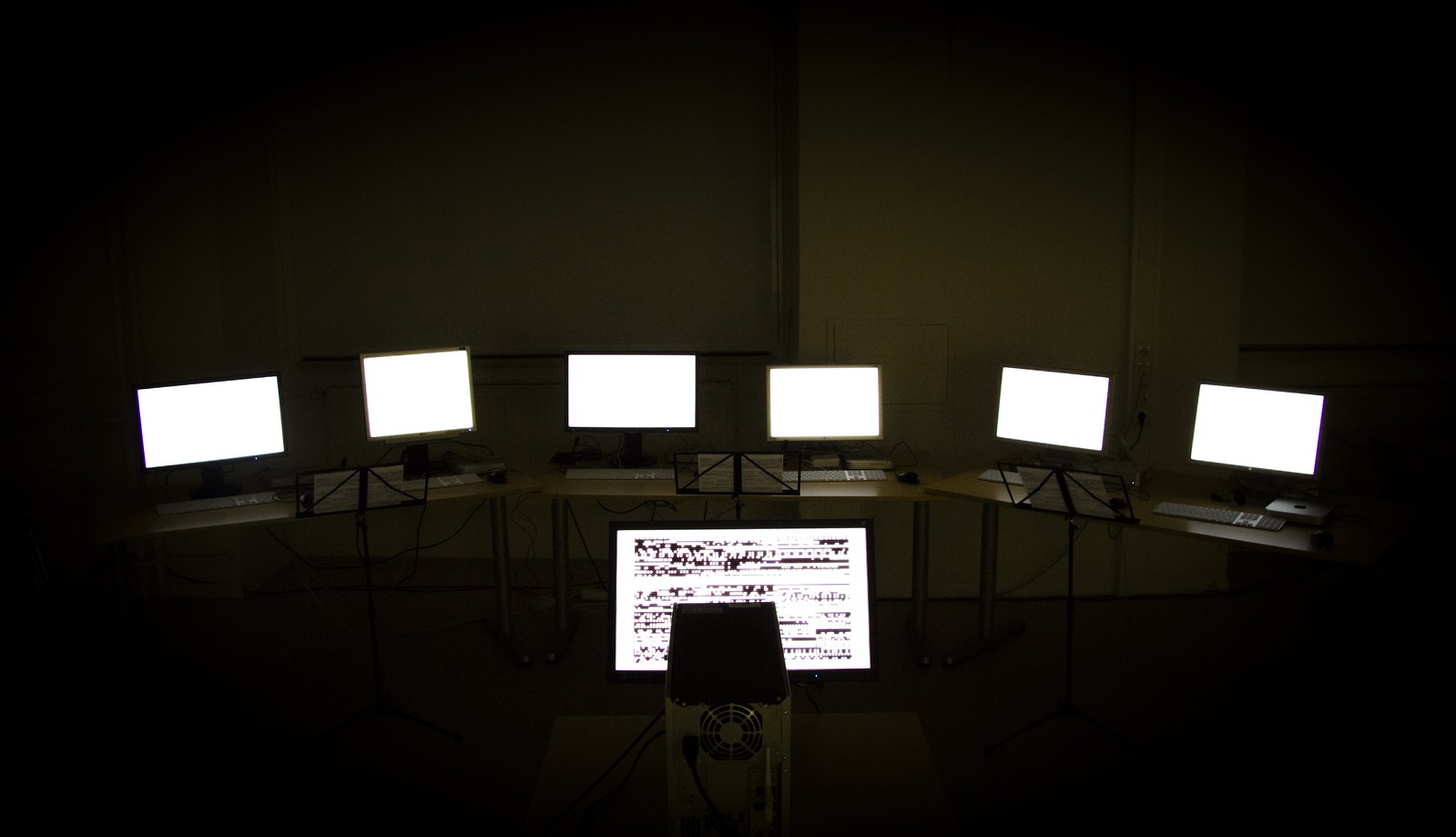
Arnulf Rainer for digital performers is a reenactment from the composition Arnulf Rainer by Peter Kubelka, which creates its visual aesthetic from the essence of the cinematic image: light and its variations. Like digital systems, it comprises solely a binary alternation of light and no light. The storyboard is a composition that appears like a digital sequence. Arnulf Rainer for digital performers is based on a software that analyzes a remade composition of Peter Kubelka in real time, in order to extract the status (black or white) for each frame. Afterwards the main computer, metaphorically seen as the director, sends the status to a device ensemble meant as players, in order to perform the composition. Their interpretation becomes the real performance, which underlines the visual property of each performer. Arnulf Rainer for digital performers is a concert played by visual media that propose a contemporary aesthetic of the original score.
The dream of flying
Chiara Esposito (IT)
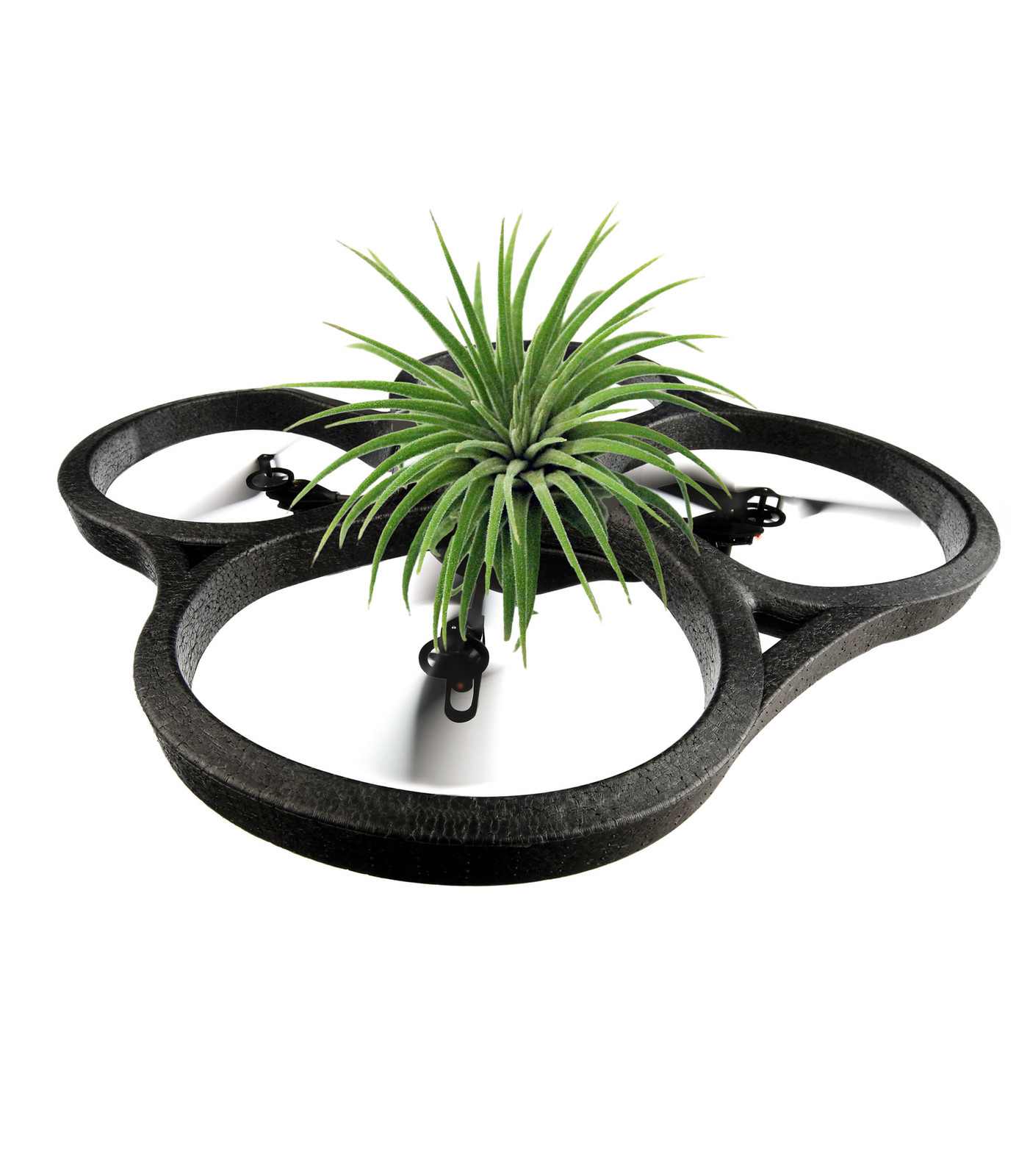
Sometimes a plant dreams of flying. Usually we associate a plant with the ground and immobility. Movement is a feature of animals. Movements in plants are usually imperceptible and associated with growth or following the sun. Plants that are capable of rapid movements look like strange chimeras. Speed is not a feature of plants. But some plants indeed have an affinity with the air and the flight: some have no roots and get their nutrients from the air, others use the wind to let their seeds move quicker, or need the action of insects or birds to reproduce. Dandelions let their seeds fly gently, other plants spit them out like rockets. Every plant reacts to the environment in a different way. In the artwork *The dream of flying*, an interface enables a plant to control a body extension: a small flying device. The interface measures the electrical activity of the plant and uses the gathered data to control the flight. The plant works here as an actor and a sensor, creating an open system in which visitors and the environment are actively participating to influence the pattern of the flying device.
Think Pink
Isidora Ficovic (SR)

This interactive video installation uses the qualitative research method of taking interviews in the streets of Linz. The public was asked the question ‘Which tool would you use to destroy a desktop?’ The most common answer was “the hammer”. The public decided the hammer should become the non-verbal communication tool. By hitting with the hammer the visitor of the exhibition triggers videos that are showing the interviews. Embedded sensors randomly open different videos, but only one is the key to the *Think Pink* when the monitor changes to become a pink color.
Memories of the Future
David Gann (DE)
The genome is the basic level of memory and contains the building plan for us as human beings. As we have begun to understand our genetic code and are more and more able to change it, it is time to think about and discuss the potential impact on future generations. In this work multiple users can explore an interactive audio-visual map of the human genome on a touchscreen. About 28,000 genes are positioned on a ring that represents the genome. The brightness stands for the expression level (how much gene product is produced) of a gene and the lines indicate the interaction between those. The genes are sonic grains on a long audio sample that contains many aspects of our culture and civilization. The user can associate his/her own audible memories with the sonification and gets a better spatial and relational understanding of the visualization. The user-interactions are recorded and the resulting data and musical compositions are published.
Science-Interactive.com, SymbioticCube.com
Street-Scape
Jaak Kaevats (EE)
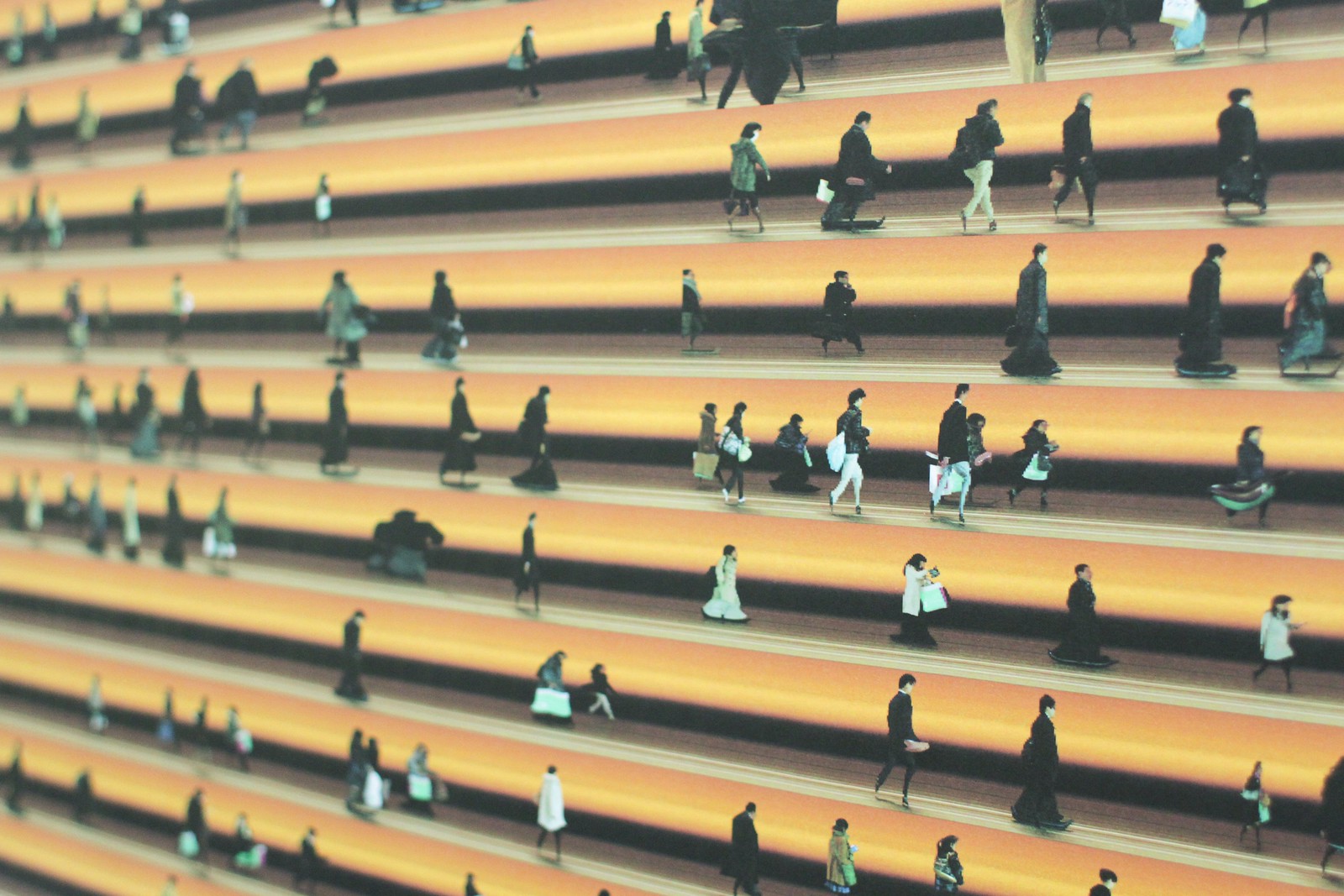
Street-Scape is a contextual visualization of an urban environment. The walking direction of people in the street is plotted in one direction on the 5-minute timeline to make their relative distances between each other more apparent. The visualizations are rendered in a way that produces people walking 5km/h (average walking speed) with original proportions, everyone moving faster becomes thinner and everyone slower is mapped respectively wider. Street-Scape renders the captured people anonymous while revealing their demographic qualities such as their approximate age and gender. Thus, presenting the relative amount of children, grown-ups, older people, bikers, etc. in a particular location during the visualized time.
http://kaevats.org/street-scape
4th Skin
Mihaela Kavdanska (BG)

The 4th Skin project visualizes what we see, touch or reflect. It is the “skin” created by our whole body & mind experience and our relations with the world around. This interactive audio-visual piece has a strong performative and site-specific component. The relations between the performer and the surroundings result in the form of ephemeral multimedia garment. The video content is created live according to the performers’ explorations with mobile filming devices: their presence in a given space, bodies, movements, actions, textures, these all become part of the dynamic garment. By acting in one way or another, the performer changes the garment’s content. The captured video footage is projected on the performer’s body using custom-developed video tracking & video mapping solution. The 4th Skin is a comment on the subjects of ephemerality, transience and impermanence. It reflects the sense-based exchange between oneself and the world around.
Programming by Cristian Iordache
Sound by Sorin Paun aka Randomform
Performers: Dolma Jover Agullo & Luis Gonzaga Hoyos
A project co-produced by KOTKI visuals
Acidable
Veronika Krenn (AT), Vesela Mihaylova (BG)
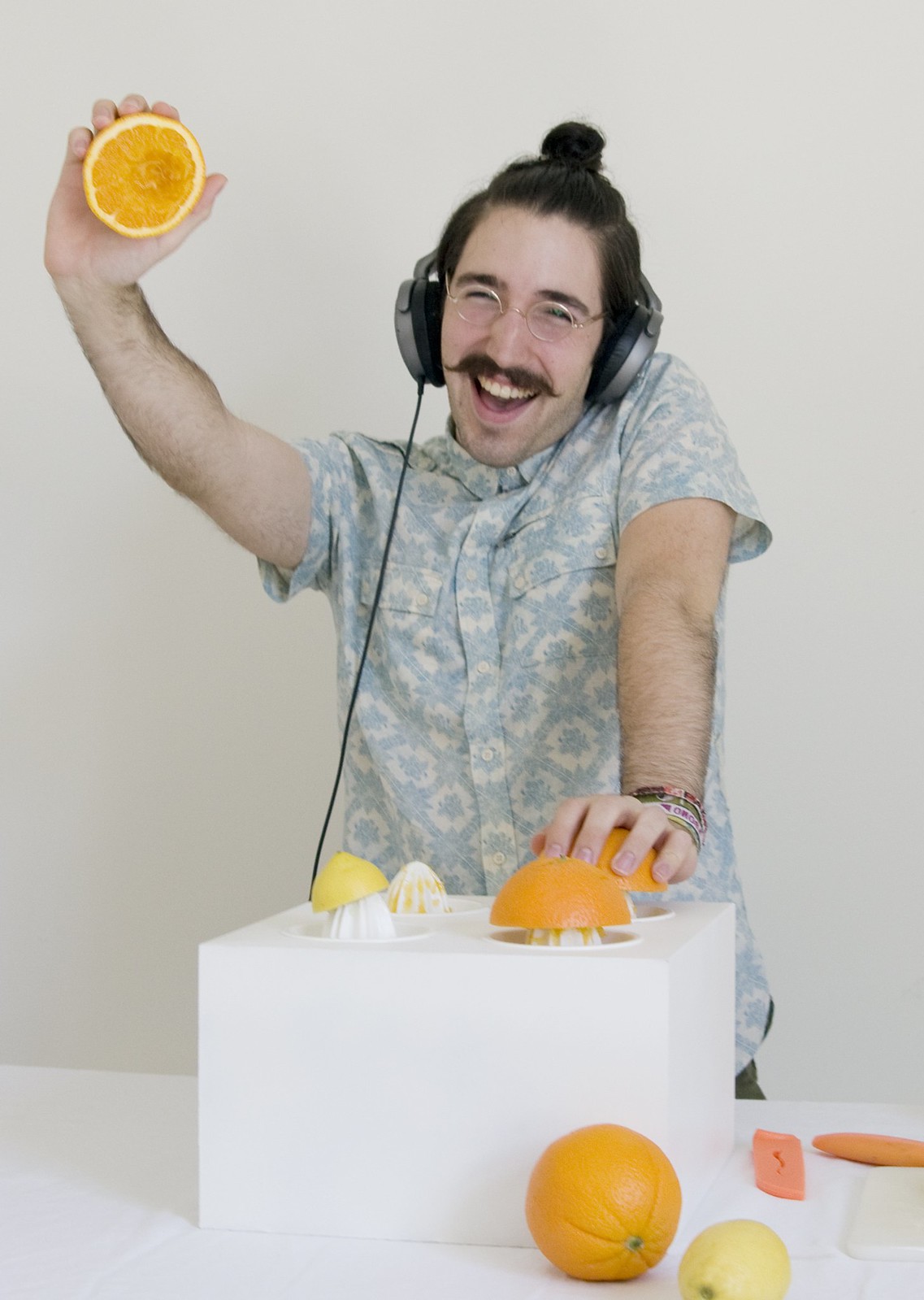
The Acidable is an interactive turntable and orange squeezer at the same time. Based on the familiar movement of manually squeezing a piece of citrus fruit, the interaction with the Acidable reaches a new level of playful experience. Depending on the pH value of the freshly pressed citrus juice, the machine creates a rhythm, and the music is modified by the motion of squeezing the fruit. This work is an interactive experiment to bring back food production into our daily life. The visitor is invited to try out the new playful device and enjoy the freshly pressed orange juice.
Digital HourGlass
Oliver Kellow (AU)
The Digital HourGlass is an abstracted hourglass form set in granite and extending an antenna towards the sky. Like sands running to the lower bulb, the Digital HourGlass will change states when the upper bulb expires. The viewer may touch the frame of the hourglass, changing the power configuration and increasing the stress on the bulb. Symbolically, it represents the consciously marked passage of time and energy, providing no reference point to gauge the amount of time or energy remaining or previously spent. The only known value is that as a physical and familiar device it must degrade and expire, the moment of transition is pure serendipity, unpredictable to both the author and the viewer. This consciousness of time, energy and decay is accentuated by the physicality of the high-consumption, antiquated Edison bulbs used. It is a simple reminder that although time and energy is always flowing, we have the opportunity and the capability to use it or alter its path.
Suppenbrunzer
Nina Mengin (AT)

The communicative and ritual aspects of eating undergo continuous changes. Fast food and convenience food have radically changed our eating behavior. One of the consequences is that individual snacks replace ritual meals within a family. Even if we eat high quality foods, we still lack the time for a proper meal. The installation quotes a traditional Austrian dining table, but it is squeezed in between walls and can only be used by one person at a time. Snacks are available next to it, and they have to be placed on the table to activate the Suppenbrunzer and start the interaction. The whole procedure only takes a few seconds, in this way the Suppenbrunzer adapts to the prevalent food culture.
A Day In A Life
Ivan Petkov (BG)
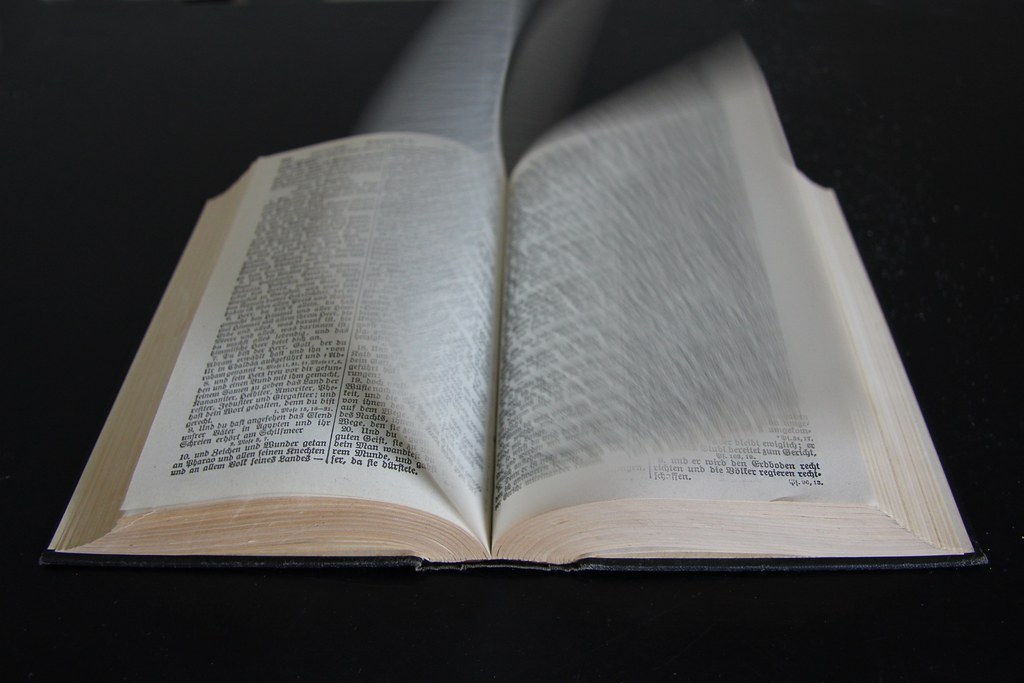
“Suffering makes you live time in detail, moment after moment.” E.M. Cioran, The New Gods.
Starting at sunrise, the pages of an empty book are turned by an airflow. At midday, the amount of the pages that have been turned roughly equals the ones that are still left. At sunset, the end of the book is reached. An unexpected usage of a book takes place in this installation. It is blank, but can still be read. In an intuitive way, without the torturous precision of the signs and by the invisible power of the wind. It reveals the time passed since the morning and the time left till dusk. It is reminiscent of a bygone era in which the active life was restricted to the daytime hours.
Micro Pets
Marie Polakova (CZ), Veselina Dashinova (BG/UK), Jan Spurny
Have you ever thought that microscopic organisms could be something more then a scientific specimen or feared disease? Something you could care for and even grow to love? The Micro Pets project looks into the unthinkable, considering microbes of infinitesimal size as endearing and captivating creatures–as playful companions with personality and charm. The artists have addressed the difficult task of observing and understanding the natural behaviors of water microorganisms Building on their practical and conceptual research, their aim is to design suitable nano toys for such creatures, together with ‘Micro Pet Lifestyle Accessories’ The toys and accessories will be specially suited to the particular behavior and needs of each microorganism group. So far one can see a design of a toy and a digital simulation of the interaction between the Micro Pets and their toys. The next aim of the artists is to develop the design further and subsequently produce the toys.
Created at Interface Cultures Lab with support from the Ars Electronica Bio Lab.
240313:Bit-Poems
by whoun a.k.a. Juan Cedenilla (ES)

240313:Bit-Poems is a collection of several poems and a possible visualization of each of them. These bit-poems are created by rules of poetry applied to bits. The contemporary world demands a different way of perceiving the digital aesthetic. For this reason, this project aims to transfer a concept of the non-digital world to the digital world and observe the result. The starting point is something created by humans: poetry. One of the main goals of poetry is to communicate. The poetry form follows a series of rules and conditions. Communication, rules and conditions are the settings of a protocol in the digital world. Visualizing this protocol can create a better non-digital understanding of it. This allows us to explore and discover the result of the translation of such a concept.
Brucknerhaus
Opening Thu 5.9. 13:00
Thu 5. 9. 10:00 – 19:00
Fri 6. – Sat 7. 9. 10:00 – 17:30
Sun 8. – Mon 9. 9. 10:00 – 19:00




In Taiwan, opposites coexist: the most advanced technology and traditional culture, the ubiquitous Chinese and 17 Austronesian tribes, democracy and corruption, a relatively small country (1/15 of the size of France) and an economic powerhouse for global high-tech industry. The conflict between Taiwan’s strong sense of national identity and its ambivalent national status in relation to China hovers in the air, charging it with a tension that can best be described as ‘Taiwan’s schizophrenia’.
Permanent digital Revolution
Schizophrenia Taiwan 2.0 also sketches the Taiwan Machine, which is based on Heiner Müller’s postmodernist drama, Hamlet Machine (1997). Technology revolutionizes the world by breaking down the traditional narrative structure and placing media at the center of the economy. Machinery is omnipresent and omnipotent for Müller, but also a universal and permanent revolution. We zoom in and focus on such digital revolution in the works of young Taiwanese new media artists, born between the eras of color television and smart phones in a country that manufactures 80% of the world’s electronic goods. These artists are fully aware of the risks and of the potential of globalization and cybernetics and their works reflect the challenges facing Taiwan and the world as a whole.
With Works by Li-Ren Chang, I-Chun Chen, Liang-Hsuan Chen, Wan-Jen Chen, Chao-Tsai Chiu, Yen-Yin Huang, Yen-Chu Lin, Yu-Hsien Su, Yu-Chin Tesng, Pei-Shih Tu, Jun-Jieh Wang, Chi-Yu Wu, Goang-Ming Yuan (all TW)
Curators: I-Wei Li (DE/TW/CA), Pierre Bongiovanni (FR), Ching-Wen Chang (TW), Chien-hung Huang (TW).
Interview with the curators at the Ars Electronica Blog.
http://www.schizotaiwan.net/
Tabakfabrik
Opening: Thu 5.9. 17:00
Thu 5. 9. 12:00 – 24:00
Fri 6. – Mon 9. 9. 10:00 – 21:00


Since 1997, the Japan Media Arts Festival has been honoring outstanding achievement in a broad spectrum of genres including animation, comics, media art and games. In 2013, more than 3,500 works from 70 countries were submitted for prize consideration.
A selection of prizewinning works from the 16th Japan Media Arts Festival shows how Japanese media artists deal with remembering and the origin of memories.
A New Platform for New Memories
The horrendous 2011 earthquake left deep scars in Japan’s collective memory. And trauma is a form of remembering. As this exhibition shows, artists have been endeavoring to come to terms with this trauma—and presumably will continue to do so for years to come.
Dolls are an established part of Japanese culture and tradition. They’re often said to have greater expressive capabilities than human beings. Supporting testimony to this effect is provided by virtual singer Miku Hatsune and the techno-pop group Perfume with choreography on the basis of motion-capture data.
With works by Google Maps 8-bit team (JP), IDPW (JP), Daito Manabe & Mikiko & Yasutaka Nakata & Satoshi Horii & Hiroyasu Kimura (JP), Nukeme (JP), Yuki Sano (JP), rrrrrrrroll (JP), Sol Chord (Shinjiro Maeda, Rina Okazawa / JP).
Thu 5. 9. 10:00 – 19:00
Fri 6. – Sat 7. 9. 10:00 – 17:30
Sun 8. – Mon 9. 9. 10:00 – 19:00
Brucknerhaus
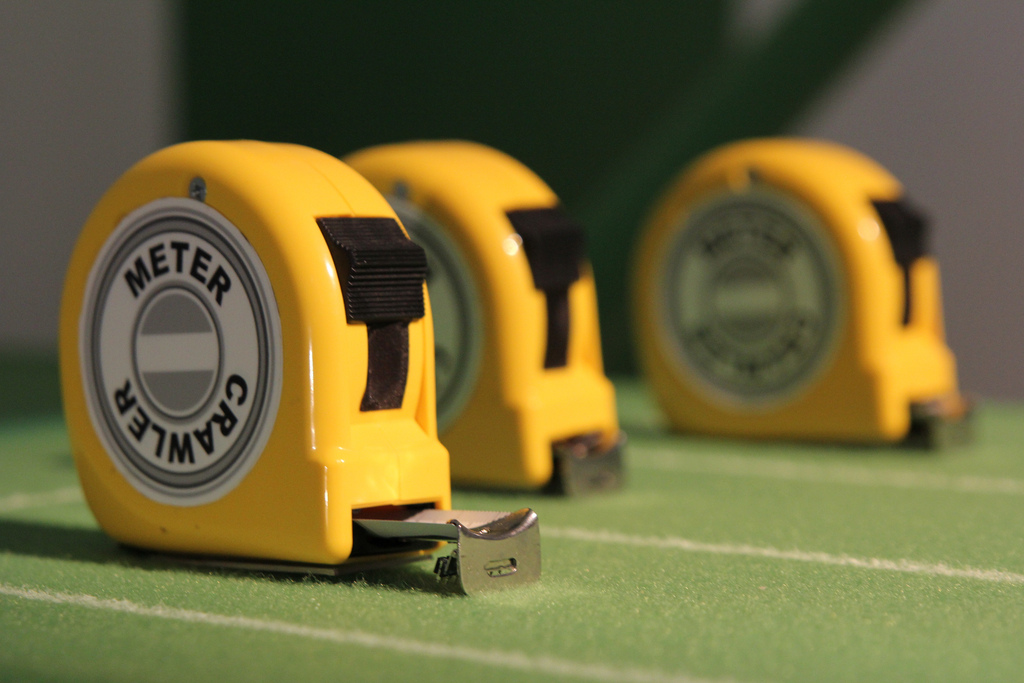
We exploit modern technologies so intensively that we’re now surrounded and pervaded by them as if by a second nature. And thanks to new tools, materials and media, we’re incessantly upgrading and enhancing this artificial nature created by and for ourselves. And the source we draw upon most frequently in going about this is our original habitat—first nature, so to speak, the flora and fauna of the Blue Planet. This is what we aim to understand, control and improve.
Artificial Tornados
Among the participants in this effort is a new type of artist with very highly developed aesthetic, scientific and social skills. “Like a Second Nature,” an exhibition originally curated for Volkswagen’s Automobil Forum Unter den Linden venue in Berlin, shows how these artists deal with the interplay of these naturally and artificially created environments—for instance, ironic takes on scientific methods, robotic plants, winking leaves and synthetically engineered tornados.
With Works by David Bowen (US), Rejane Cantoni & Leonardi Crescenti (BR), Ivan Henriques (BR), Alistair McClymont (UK), Yasuhiro Suzuki (JP), Keiko Takahashi (JP)
The exhibition is shown in the Ars Electronica Center.
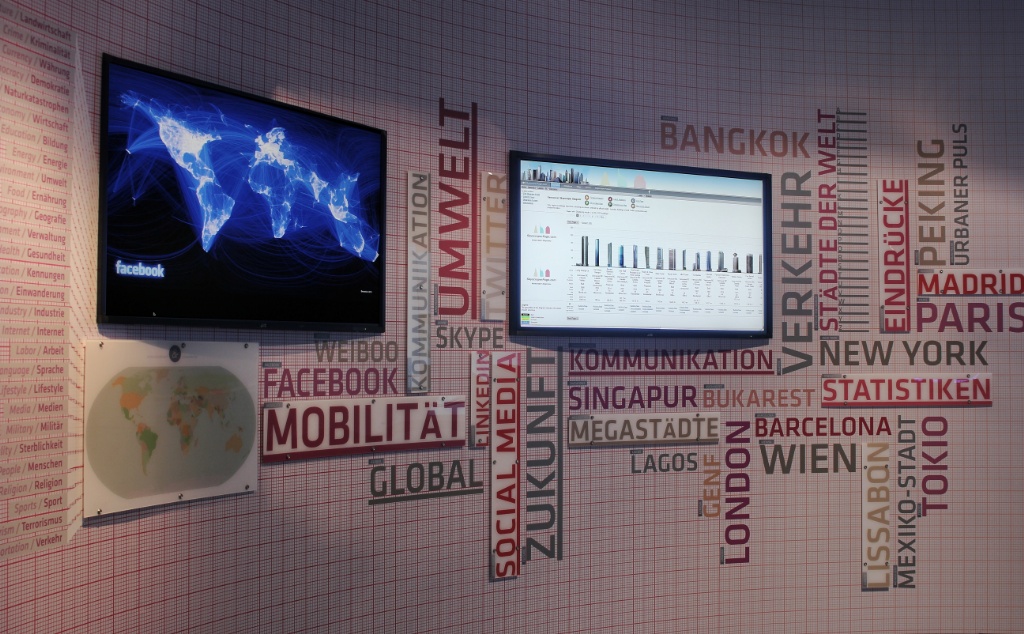
More than half the world’s population lives in cities at present; in 2050, the figure will be two-thirds. Thus, the already densely populated metropolises, their complexity already almost beyond comprehension, will soon be facing daunting challenges. GeoPulse presents an instrument that will be indispensible to doing urban planning under these circumstances: state-of-the-art simulation & visualization tools. This is the only effective way to visually, intuitively depict and experience the data and information that’s associated with urban life.
Walk-through Database
In addition to images, videos, texts, maps and infographics, the exhibition features a walk-through interactive database. Touching surfaces with a digital pen launches book pages, city maps, wall displays and other objects. Comparing Linz with megalopolises like Beijing enables installation visitors to playfully experience local and global development processes in the city of the future.
This exhibition is in the Ars Electronica Center, find out more at ars.electronica.art/center/en/ausstellungen/geopulse.
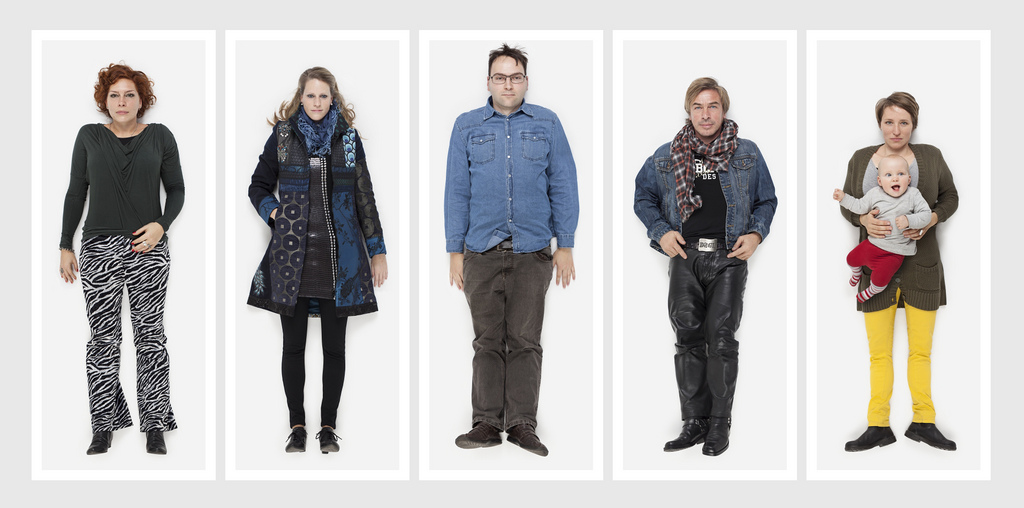
Upper Austrian photographer Kurt Hörbst’s full-body scans reconnoiter the surfaces covering and adorning the human body in search of remarkable details. His imaging technique is an intentional deceleration of high-speed digital photography. The portrait subjects lay flat on the floor while they’re digitally scanned, one pass after another, by a high-definition digital camera. The subjects have to freeze and maintain their pose for one to two minutes.
This exhibition is in the Ars Electronica Center.
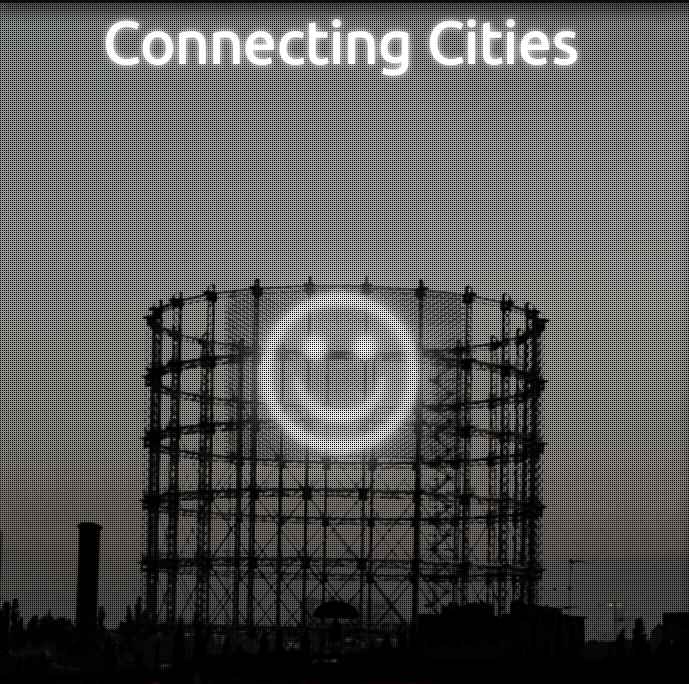
Exhibition
Ars Electronica Center, Zwischengeschoß
Thu 5. 9. 10:00 – 21:00
Fri 6. 9. 10:00 – 24:00
Sat 7. – Mon 9. 9. 10:00 – 21:00
Projection
Ars Electronica Center, Media Facade
Thu 5.9. 23:00 – 24:00 Connecting Monsters
Fri 6.9. 21:00 – 22:00 Connecting Monsters (Live Connection with Istanbul)
Sat 7.9. 22:00 – 23:00 United Colors of Dissent
Sun 8. 9 21:30 – 22:30 United Colors of Dissent
Connecting Cities is a network of urban media façades, jumbo-size screens and projection surfaces in Aarhus, Berlin, Brussels, Dessau, Helsinki, Istanbul, Liverpool, Marseille, Madrid, Montreal, Riga, São Paulo, Vienna, Zagreb, and the media façade of the Ars Electronica Center in Linz.
Otherwise usually the preserve of advertising, this high-impact media infrastructure is now available to media artists and urban activists too. In numerous instances, the interactive contents featuring artistic positions and sociopolitical commentary are mutually referential or are displayed simultaneously in several cities.
On the Wall and Behind
The Ars Electronica Festival is showcasing three outstanding works in an exhibition and on the media façade of the Ars Electronica Center: Connecting Monsters by h.o (Hideaki Ogawa, Emiko Ogawa, Junichi Yura, Naohiro Hayaishi,Taizo Zushi / JP) with a synchronized display on Beşiktaş Square in Istanbul, Binoculars to … Binoculars from … by Mar Canet (ES) and Vavara Guljajeva (EE), and United Colors of Dissent by Orkan Telhan (TR) & Mahir M. Yavuz (TR).
Connecting Cities Network initiated by Public Art Lab in co-organization with Ars Electronica, Media Architecture Institute, FACT, Amber Platform, Museum of Contemporary Art Zagreb, m-cult, Medialab-Prado, iMAL, Foundation Riga 2014 and Videospread. Funded by the European Commission – Programme Culture; supported by Streampark TV and ARTE Creative.
Exhibition
Ars Electronica Center, Zwischengeschoß
Thu 5. 9. 10:00 – 21:00
Fri 6. 9. 10:00 – 24:00
Sat 7. – Mon 9. 9. 10:00 – 21:00
Projection
Ars Electronica Center, Media Facade
Thu 5.9. 23:00 – 24:00 Connecting Monsters
Fri 6.9. 21:00 – 22:00 Connecting Monsters (Live Connection with Istanbul)
Sat 7.9. 22:00 – 23:00 United Colors of Dissent
Sun 8. 9 21:30 – 22:30 United Colors of Dissent
Due to the weather, Sphæræ is not open anymore on Monday.
Cocky Eek (NL), Synergetica Lab (NL), ArtScience Interfaculty (NL)

Sphæræ is an inflatable pavilion with multiple domes, the interior surfaces of which serve as projection surfaces for artistic-scientific works. In this construction by designer Cocky Eek, the Dutch group Synergetica Lab will present a series of performances and installations. While addressing different senses, they all have one thing in common: each refers in some way to the field of synthetic biology, and is the result of an artistic search for the origin of life connected with an attempt to rewrite its code.
With Works by Martijn van Boven (NL), Evelina Domnitch & Dmitry Gelfand (BY/NL), Cocky Eek (NL), Eduard Haiman & Michael Holub & Evgeniy Vashenko & Vadim Smakhtin (RU/UA), Theun Karelse (NL), Francisco López (NL/SP), Bas van Koolwijk (NL), Arthur I. Milller (UK), Matthijs Munnik (NL), Eric Parren (US), Nenad Popov & Erfan Abdi (NL), Paul Prudence (UK), Joost Rekveld (NL), Joris Strijbos & Yamila Rios (NL), Dieter Vandoren & Mariska de Groot (NL)
All events at Sphæræ in the schedule
Ars Electronica Quarter
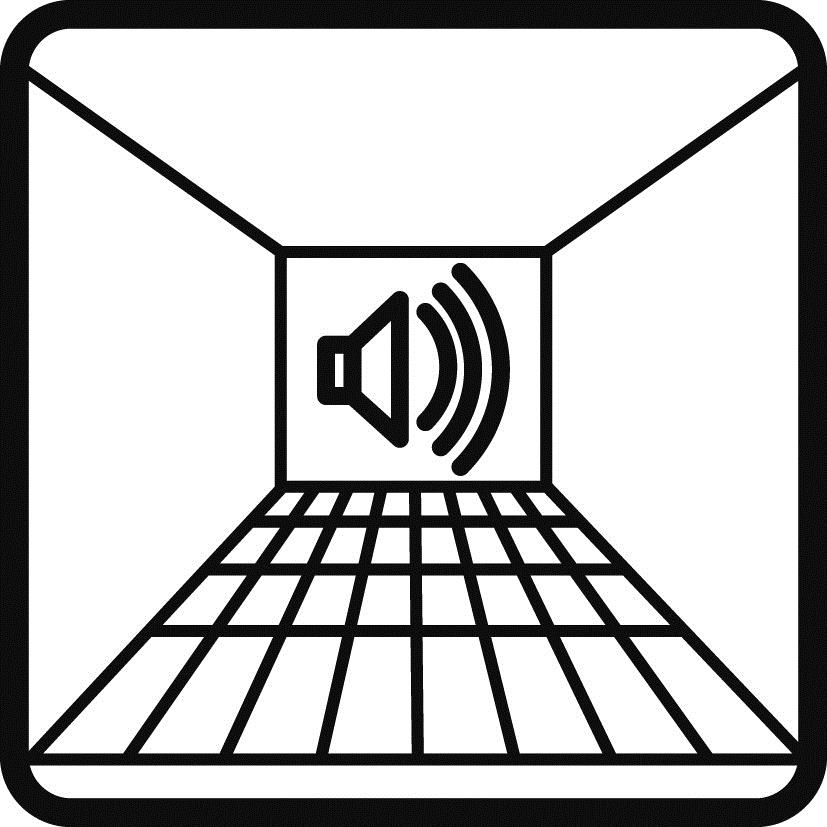
Whether in the form of the spoken word, sounds and noise, music or silence: the interrelationships among architecture, space and sound are essential elements of life. The variables entail such heterogeneous fields as psychoacoustics, environmental acoustics, spatial acoustics and structural engineering, and involve questions of architectural design as well as sociopolitical issues. After all, both architecture and sound have social functions, and both are embedded in the balance of power prevailing in society. “Architecture and Sound” scrutinizes the history of the intellectual confrontation with this topic extending all the way back to Greek Antiquity, focusing especially on experimental settings that examine this thematic complex through the interplay of research and artistic production.
With works by Anja Barbara Aichinger (AT) & Reni Hofmüller (AT), Billy Roisz (AT) & Ana Threat (AT), Reinhard Gupfinger (AT) & Maurizio Nardo (AT), Sun Li Lian Obwegeser (AT) & Gerald Roßbacher (AT), Clemens Bauder (AT) & Ilpo Väisänen (FI), Jakob Dietrich (AT) & Kai Maier-Rothe (AT), Davide Tidoni (IT), Enrique Tomás (ES), Verena Schoißengeyr (AT) & Katja Seifert (AT) & Felix Vierlinger (AT)
Curated by: Andre Zogholy (AT), Ewald Elmecker (AT)
afo architekturforum oberösterreich
Wed 4.9. – Mon 9.9. 14:00 – 17:00
For this show marking the centennial of its founding in 1913, the MAERZ artists association is opening up for the first time the archive it has maintained since the 1970s. The collection includes invitations, catalogs, correspondence with many famous members and, above all, posters. Over the course of several decades, poster art was the expression of how MAERZ defined itself artistically, emblematic of an attitude that manifested itself mostly beyond the realm of conventional aesthetic conceptions.
Until Fri 6. 9.
Künstlervereinigung MAERZ
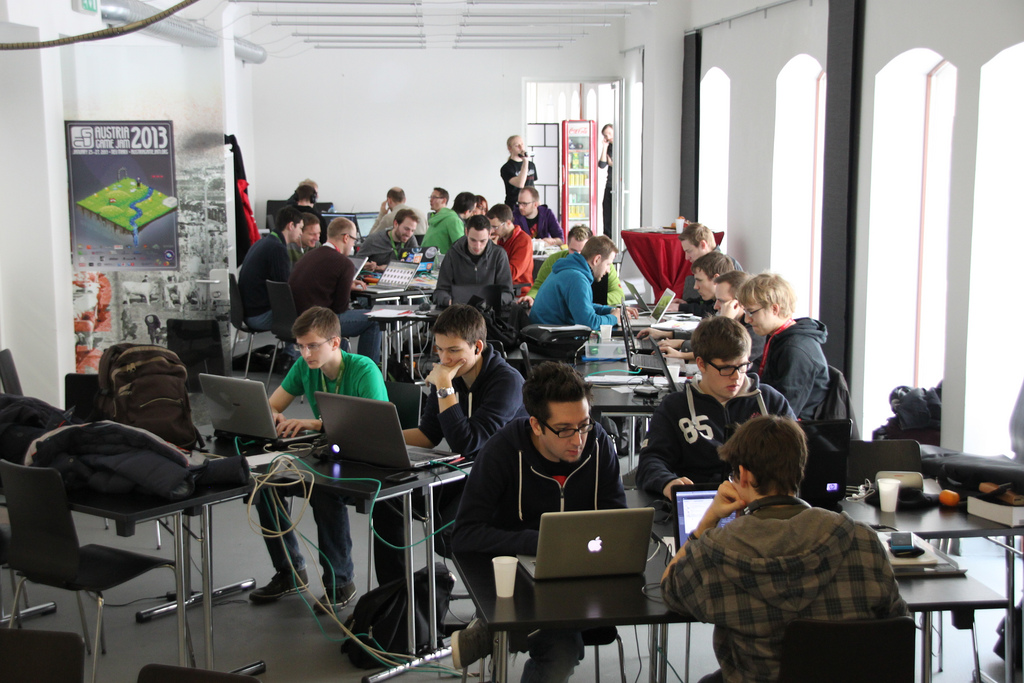
Game Jam is a compact demonstration of how digital games are produced and what steps developers go through on the way from concept to playable prototype. Creative work within prescribed limitations, spontaneity and teamwork are the characteristics of joint improvisation in the computer game medium. Participants come from various disciplines: visual arts, the audio field, interaction design and software development.
Only 48 Hours
The Jam’s creative impulse is the theme, which remains a secret until kick-off. In the case of Game Jam at Ars Electronica, though, it will definitely have to do with the festival theme, TOTAL RECALL.
Once it’s announced, jammers have 48 hours to translate it into a game prototype. The point of departure is a brainstorming session, the immediate result of which is the formation of crews.
During the Jam, festivalgoers are invited to drop in to get a glimpse at game development, see how things are coming along, and try out the final products.
Sign-Up for Game Jam
Public Hours
Sat 7. 9. 15:00 – 19:00
Sun 8. 9. 16:00: final presentation
Mon 9. 9. 10:00 – 21:00
MEGA e.V. – Museum of Electronic Games & Art (DE)
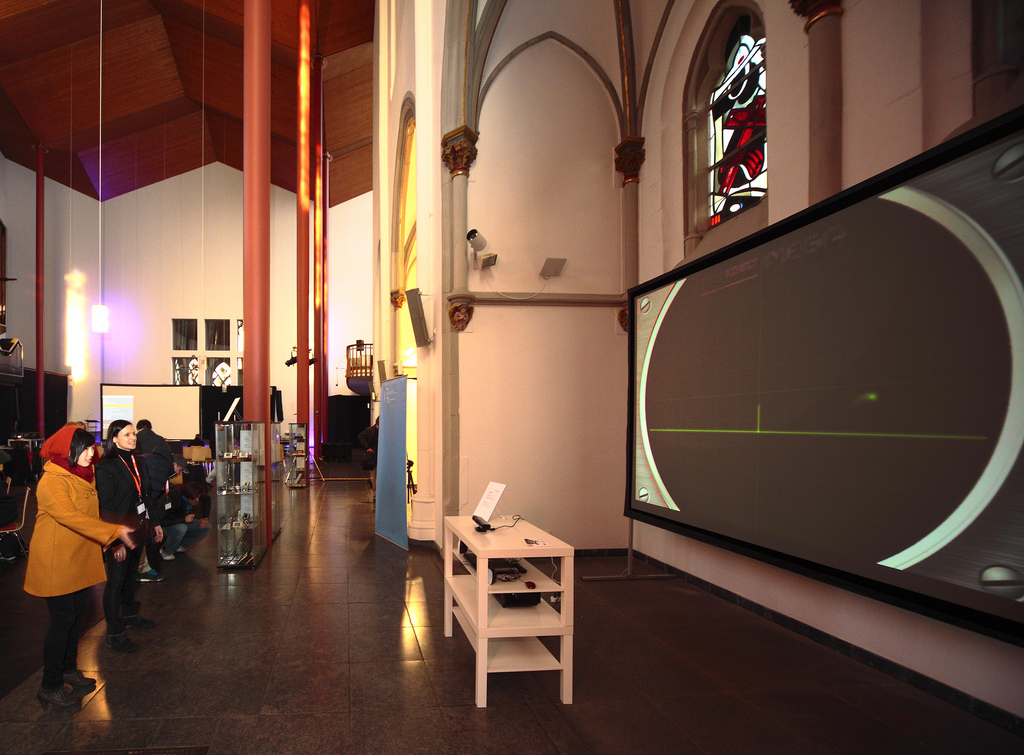
Media are bearers of cultural memory. This also applies to electronic games, which have become a mainstay medium and an essential mode of cultural expression that plays a formative role in many people’s childhood memories.
MEGA’s Ludic Memento exhibition is a journey through time from the birth of electronic games to the present. It shows how important it is to conserve, restore and reconstruct gaming systems as a means of avoiding digital amnesia.
Digital Cultural Heritage
The objects on display allow for a profound substantive encounter with the history of technology and with the visual, auditory and hapitic aspects of the gaming experience. The exhibition proposes a new form of cultural transmission and, together with the Retro/per/spektiven exhibition, lodges the claim that this mission is beyond the purview of conventional institutions of commemoration and preservation.
Tabakfabrik Linz
Back to top
Bildschirmsprünge (AT), Fachhochschule Hagenberg (AT), GameStage (AT)
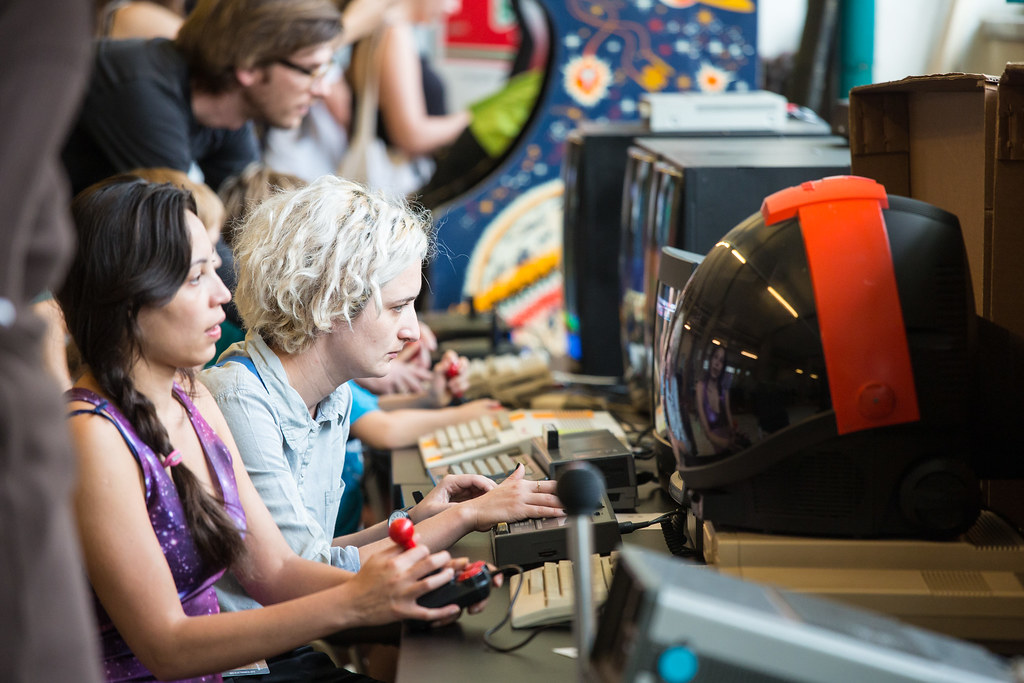


Computer games have undergone a considerable metamorphosis over the past 40 years of their digital existence, progressing from moving points of light as an entertaining test of dexterity to complex and artistically interesting interactive productions. Technological constraints imposed by the respective hardware have played a significant role in the conception and implementation of novel game ideas. At the same time, there has always been a constant demand for higher-performance hardware that effectively redefines the bounds of the possible. Thus, yesterday’s devices incessantly become obsolete, ending up in a drawer, the basement or the trash can. They may be gone, but they’re not forgotten
Arcade-Games and Old Consoles
Retro/per/spectives examines the evolution of the medium of computer games on the basis of its hardware and technological developments over the last four decades. Due to frequent media discontinuities and the failures of technical innovations, many of these devices have morphed into artifacts. Arranged on a timeline, the items on display—classics such as Pong, original arcade games, and the first networked home consoles—can be experienced and played.
Emulation or Original?
For selected games, the exhibition offers the authentic experience of playing on the original device, and also juxtaposes it to playing an emulated version on a modern processor. Thus, every player can decide for him/herself to what degree a contemporary knockoff retains the significance of the original or whether all that these digital duplicates constitute are decontextualized relics.
Retro/per/spectives is presented as the historical counterpart of Ludic Memento, an exhibition from MEGA – the Museum for Electronic Games and Art.
Team: Jeremiah Diephuis (AT), Andranik Ghalustians (AT), Stefan Schraml (AT)
Tabakfabrik
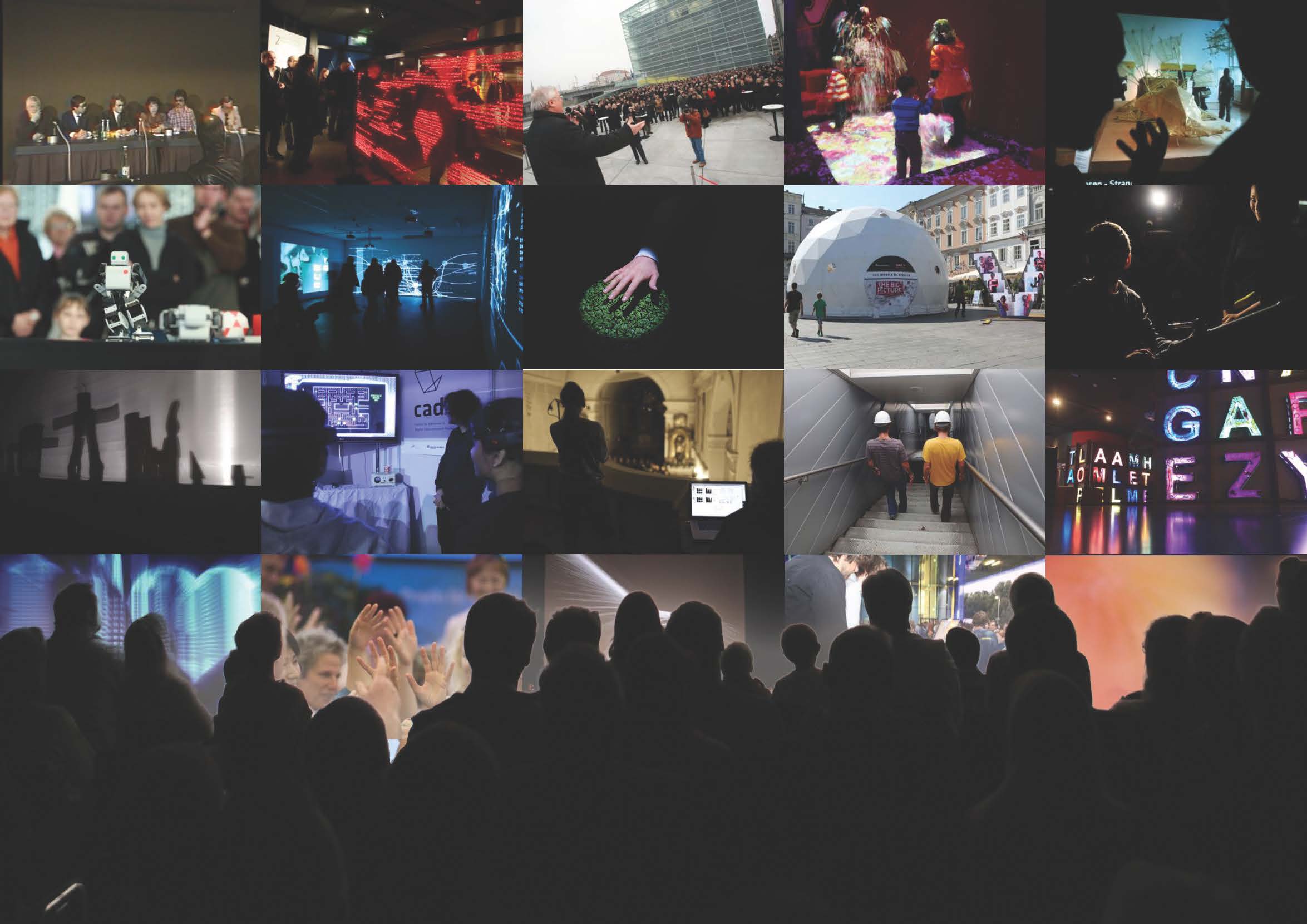
Undergrads at Queensland University of Technology (AU), a group of youngsters associated with the u19 – CREATE YOUR WORLD Festival, and various festivalgoers are going to try out a new and different form of festival documentation. Instead of filming the goings-on at the festival as neutrally, as objectively as possible, the focus this time around is going to be on a subjective, personal festival experience. Equipped with wide-angle Action Cams, they’ll be sent out into the hustle and bustle for the length of one battery charge. What they cover and how they do it is completely up to them.
Subjective Point of View
They should go out and capture what appeals to them, which is not necessarily the stuff that producers, curators and artists consider interesting and worthy of digital immortality.
Once each swarm has scoured the festival grounds for sweet images, it’s time to buzz back to the Beehive, the Mobile Ö1 Atelier on Hauptplatz. Here, they can turn in their SD cards, upload all the data, and finally view their material on jumbo screens.
Mobiles Ö1-Atelier, Hauptplatz
Hiroshi Ishiguro (JP)
Seven years ago, Hiroshi Ishiguro (JP) created the remote-controlled android Geminoid HI-1 as a copy of himself. Equipped with 46 servomotors and various sensors, it’s one of the most complex robots ever built and is correspondingly difficult to transport. Accordingly, Ishiguro built a more mobile version, Geminoid HI-4. This lightweight model can converse with humans, and has 12 servomotors for facial expressions as well as eye and head movements.
Ishiguro and Geminoid HI-4 are usually not at the same place at the same time. While one of the two is out delivering a speech somewhere, the other is at work, maybe in Japan. Or vice-versa.
Fri 6. 9 – Sat 7. 9
Ars Electronica Center, Robolab
Back to top
Erika Jungreithmayr (AT), g.tec medical engineering (AT)

Does our brain react differently to celebrities’ facial features then it does to those of people we don’t recognize? Erika Jungreithmayr and g.tec medical engineering look into this. They began by photographing 50 visitors to the Ars Electronica Center and storing these portraits to a database.
Festivalgoers interested in finding out more about this can participate in the second part of the experiment: the faces will be shown to them while a brain-computer interface measures and graphically depicts their brain waves.
Ars Electronica Center, Level -3
What does Souvenir remind you of? - an interactive performance-installation
Alias Rosalie (AT/IT), Giovanni Jussi (IT), Mario Stadler (AT), Maria Spanring (AT)
Thu 5.9. – Mon 9. 9. 10:00 – 21:00 Uhr
Hauptplatz
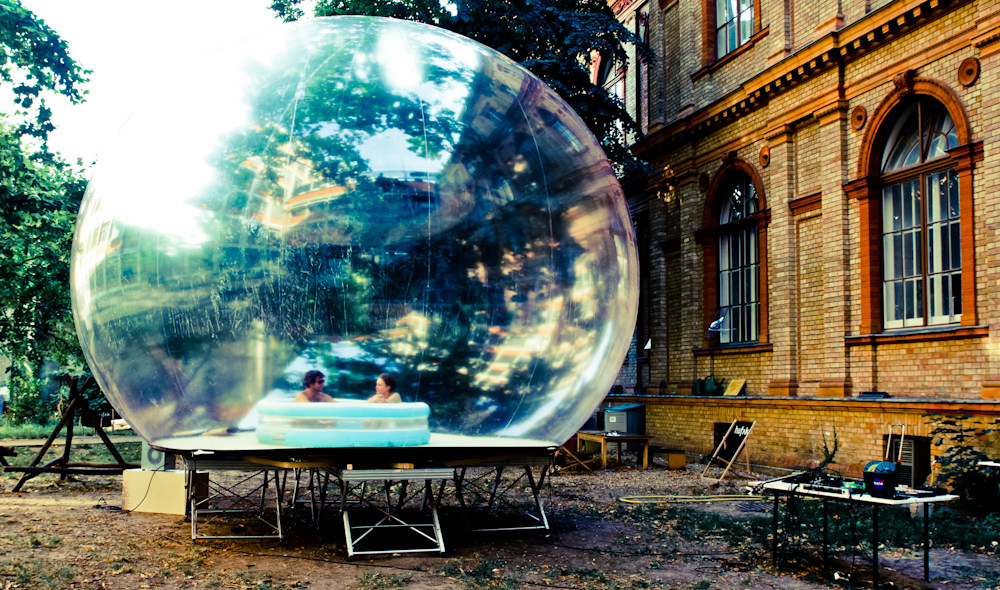
A souvenir is a mostly simple thing, with which one associates a mostly complex image or sensation of a former experience — a memory. Memories appear inside a huge snowball souvenir on Hauptplatz – just view what‘s inside, or take a headphone and listen to it, or even let it snow …
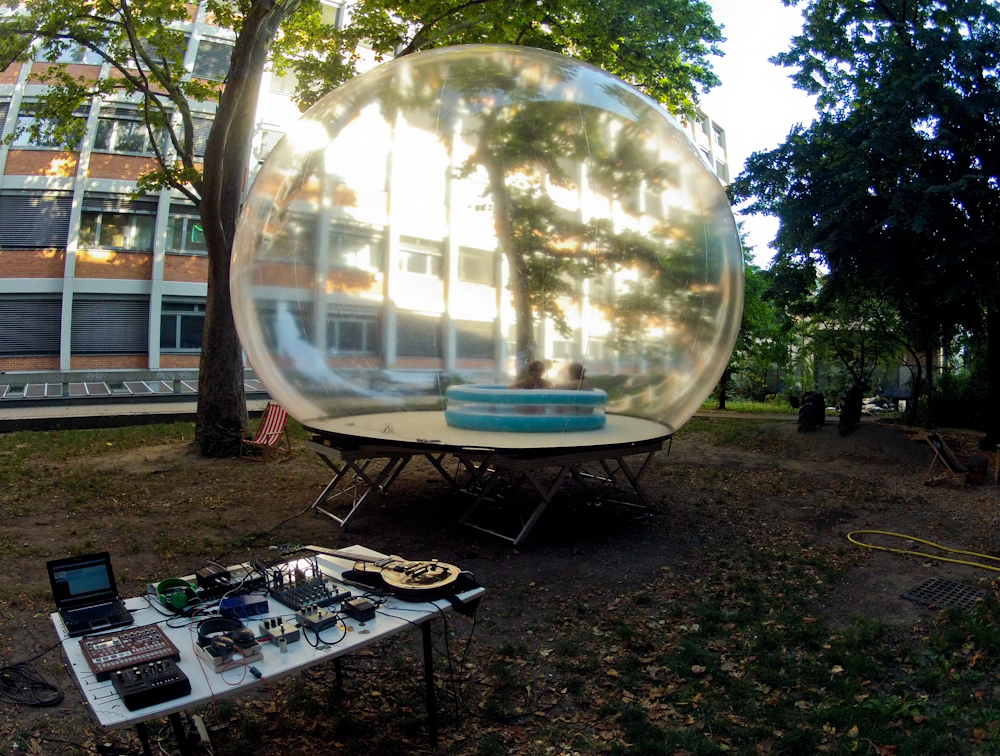
We are supposed to register, restore and recall as much as possible, in order to function appropriately in our fast world of consume. What does Souvenir remind you of? is to the offer of a gentle counter pole, the invitation of a conversation between the installation, the spectators and the surrounding space.
Thu 5.9. – Mon 9. 9. 10:00 – 21:00 Uhr
Hauptplatz
